When Hyundai first released the specs of the Kona EV, we were all salivating – an EV well under $100K with a ‘real world‘ range of 400km? Bring it on.
And then we got the VW e-Golf to review, with its ‘real world’ range of 220km. That range was worked out by a couple of journalists driving south from Auckland in an e-Golf and they got to Tokoroa before needing to recharge. That drive to Tokoroa is a pretty easy one, maybe one of the gentlest drives in the country. Don’t get me wrong – I loved the e-Golf – but claims of ‘real world’ need to be read very carefully.
So, to the Kona EV. We really like the petrol version of the Kona – looks great, goes well (in the 1.6 turbo version, at least). This seemed like a good starter for an EV.
But the thing is, when you talk to people about driving an EV, more often than not, their first reaction is, “but how long will it take me to get to Auckland from Wellington?” – because that’s something we do lots of (insert Tui slogan here). According to the stats, the average New Zealand driver does 27km a day, not 600km. But yes, there are times when you need to drive that far – I do this trip about six times a year.
So the gauntlet was thrown down – just how many times would we need to recharge the Kona EV driving from Wellington to Auckland and back? And how much extra time would it take, over using a petrol-powered car?
You called for real world, we answered.
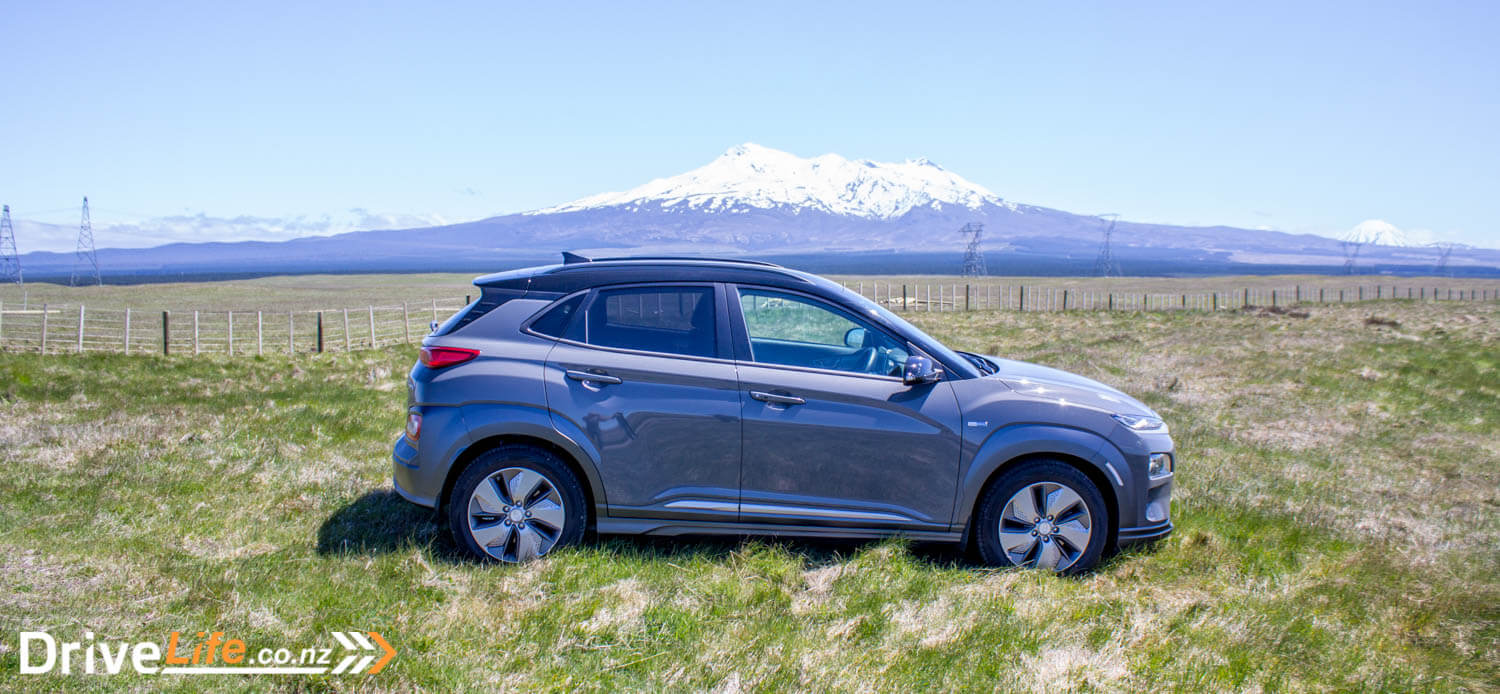
What’s In The 2018 Hyundai Kona EV Range?
There’s just two EV Konas available in New Zealand; the base version (Kona Electric) and the Kona Electric Elite model (tested). The base version kicks in at $74,900 while the Elite model is priced at $79,900. Is that a lot for a small Korean SUV? Certainly is. You could get an entry level Jaguar E-PACE for that money, or the ever-brilliant Volvo XC40 in top-spec, with $7K left over.
Both Kona EVs are front-wheel drive only, and both have a 150kW electric motor (giving you a meaty 395Nm of torque) and a 64kWh (kilo-watt-hour) battery pack. The battery capacity of 64kWh is where all the excitement is at; in comparison the Toyota Prius Prime has an 8kWh battery pack, the VW e-Golf, 38.5 kWh, and even Hyundai’s own Ioniq EV has a battery capacity of 28kW. 64kWh? That’s huge, and not that far off the 75kWh capacity of the cheapest Tesla, the Model S P75D at $125,000.
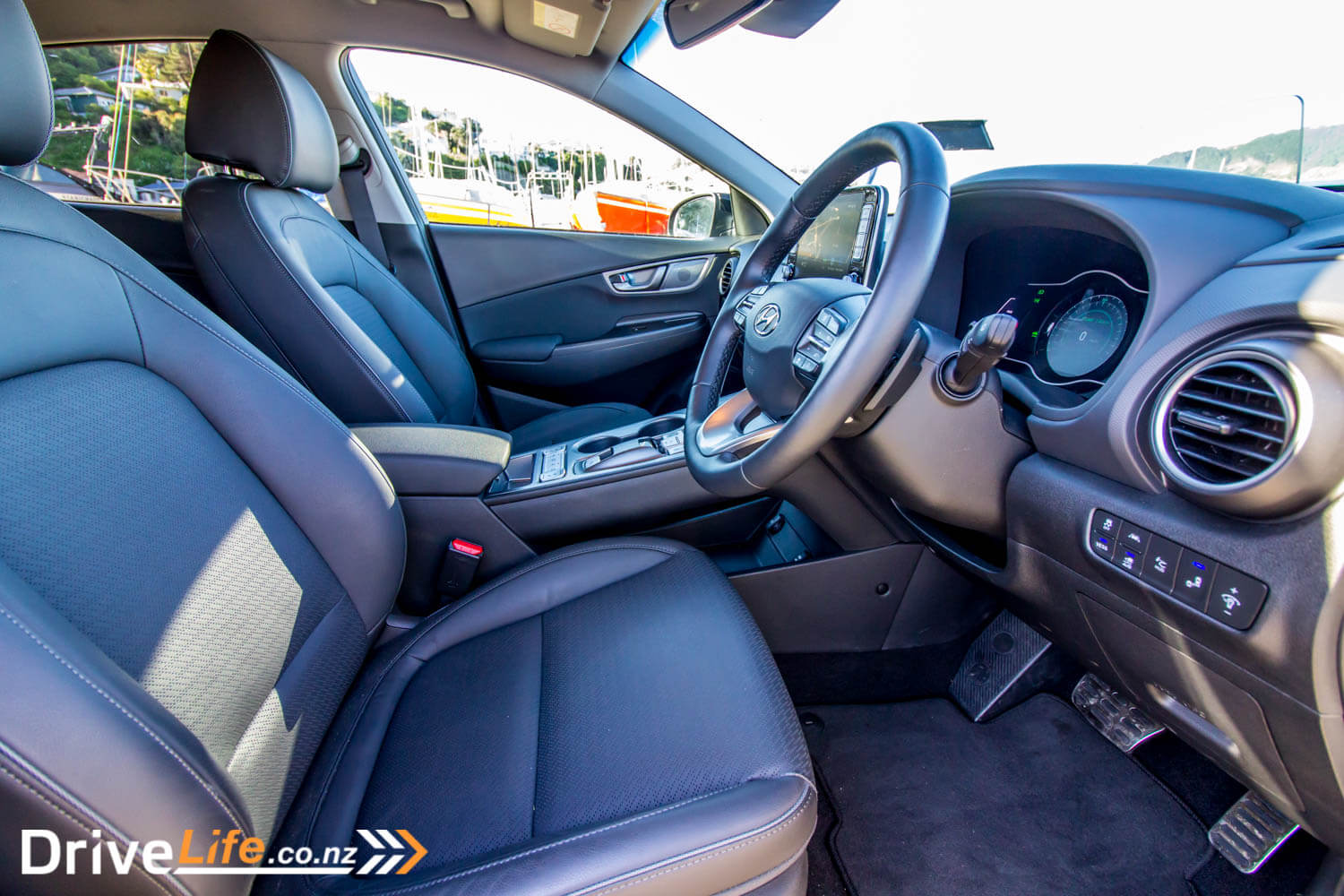
As far as equipment goes, for the base model as standard kit you get 6 airbags, rear park assist, tyre pressure monitoring, leather steering wheel, 6-speaker audio system, 7” central touchscreen display with Android Auto and Apple CarPlay capability, auto dimming rear view mirror, adaptive cruise control, 17” alloy wheels, LED daytime running lights, auto headlights, LED tail lights, and Hyundai’s SmartSense pack which includes blind spot monitoring, rear cross traffic alert, lane keep assist, forward collision avoidance, and driver attention warning.
The Elite model ups the ante quite a bit, and I expect would be the choice of the two for most buyers. On top of the base model, it then adds high beam assist, lane following assist, front park assist, a leather interior, heads-up display (HUD), Qi wireless phone charging, ventilated and heated front seats, heated steering wheel, 10-way power adjustable driver’s seat, 6-way power adjustable passenger’s seat, the display is increased to 8”, LED headlights, and an upgrade for the sound system to a Krell premium audio system with 7 speakers including a sub woofer.
You’ll notice SatNav isn’t on the list yet, until 2019 when Hyundai NZ gets Australian-spec Kona EVs, SatNav will not work. It is installed in the car, but doesn’t function. So a bit of buyer beware here, if you buy a Kona EV now, Satnav and associated functions will not work, and you can’t get them going later.
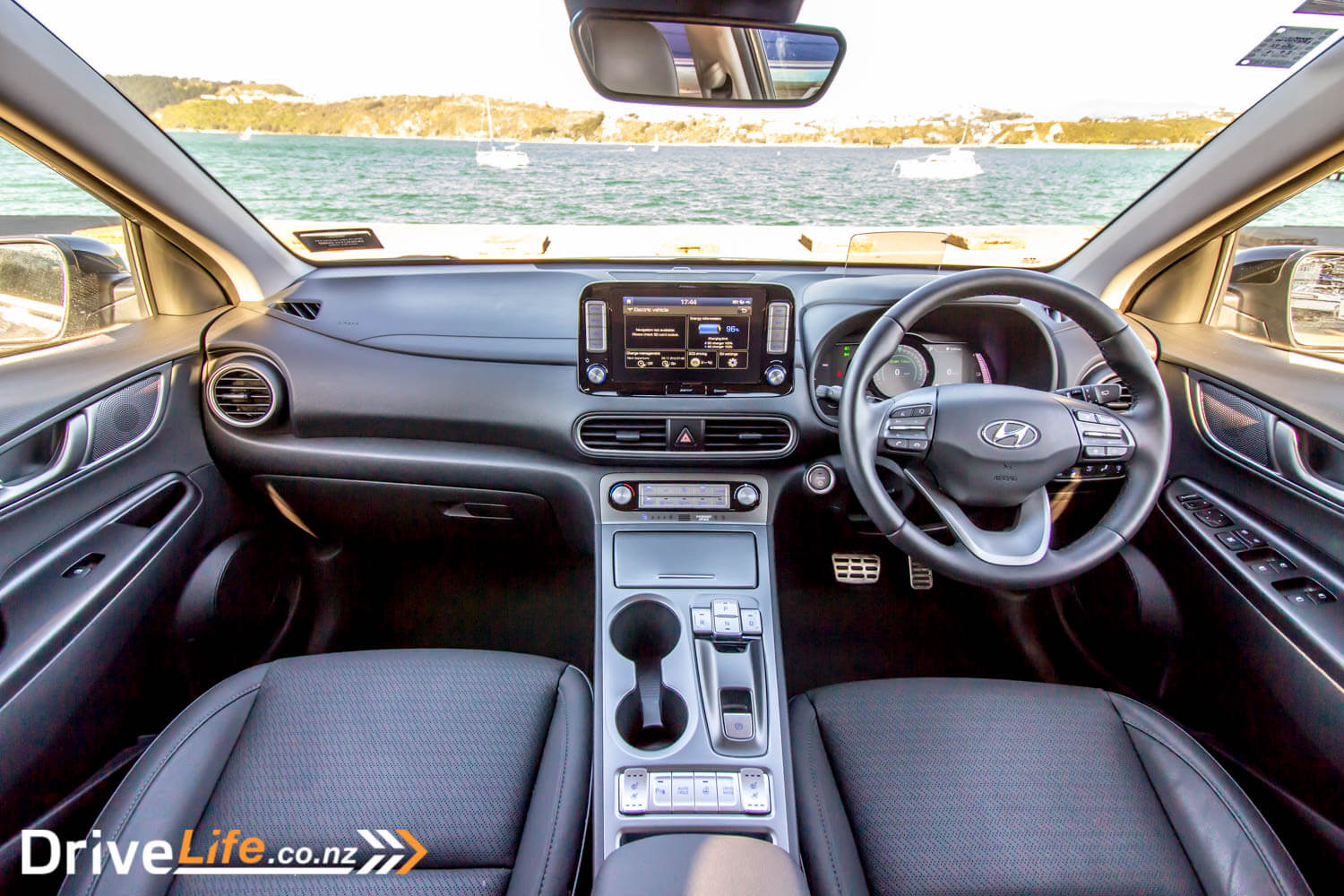
First Impressions Of The 2018 Hyundai Kona EV Elite
After turning up at the dealership to pick up the Kona EV, I spied a metallic red Kona that looked great. My first thoughts were how good it would look in photos in that colour. And then the sales manager brought to me the one we were actually testing – in an insipid, flat grey which is named Galactic Grey.
I know I’ve said this before, but I can’t understand why manufacturers insist on making the EV version of their petrol cars ugly. The Kona is a great looking car – I love it. The front, back, sides – all good. But then when they made it an EV, they took away the grille and put in a big ass piece of plastic.
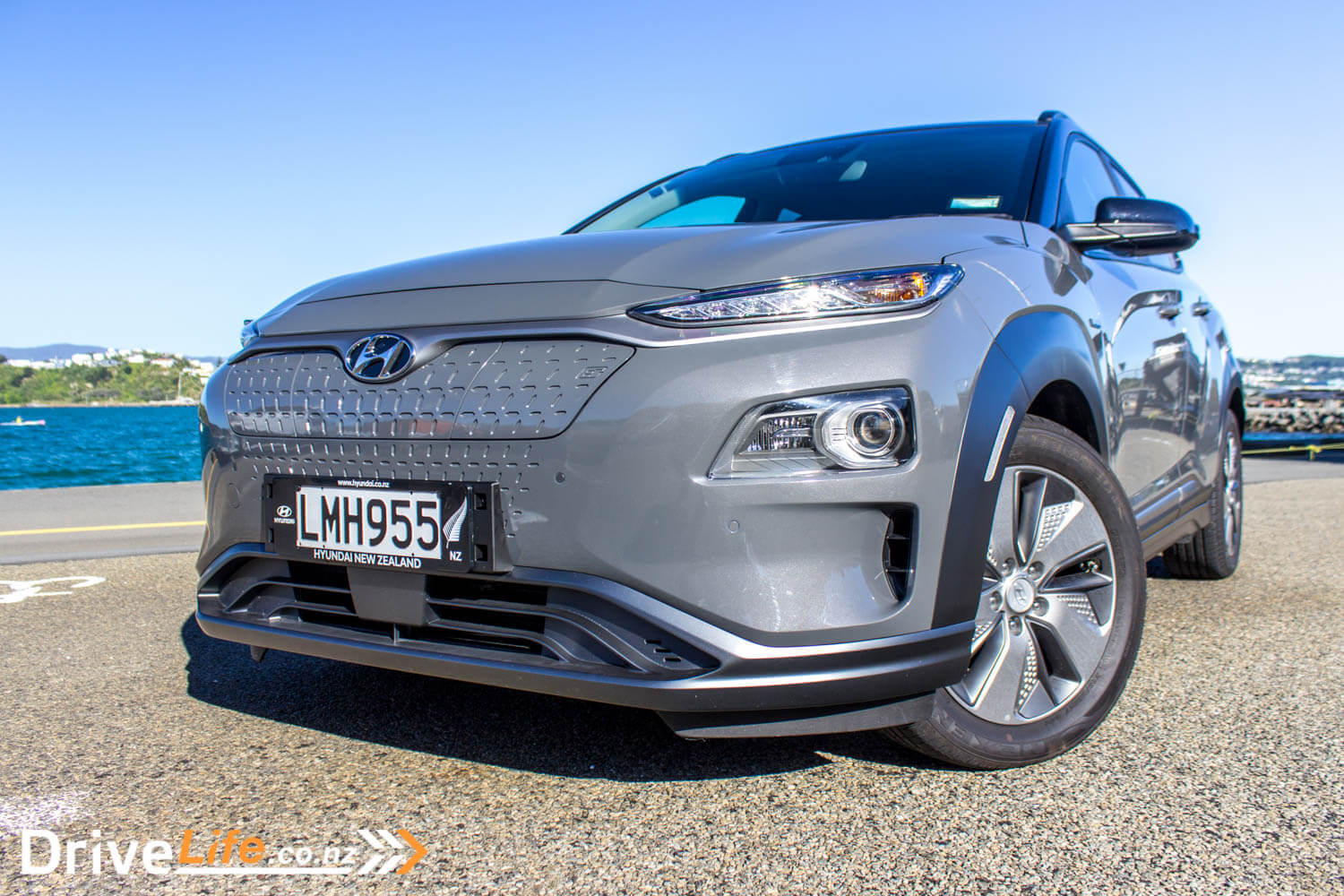
It doesn’t stop there – they’ve taken the good-looking wheels off the Kona, and put on some ugly ones that come complete with plastic inserts. I’m sure it’s all very much more aerodynamic or something, but it has ruined the look of the car. Thankfully the back remains the same (sans the exhaust), so there’s some saving grace there.
If it were mine and I was able to, I’d switch the ugly plastic at the front for a normal grille, and make it look good again. The trouble is, the charging point is up there so doubtful you could do that.
Please Hyundai, make it look good again.
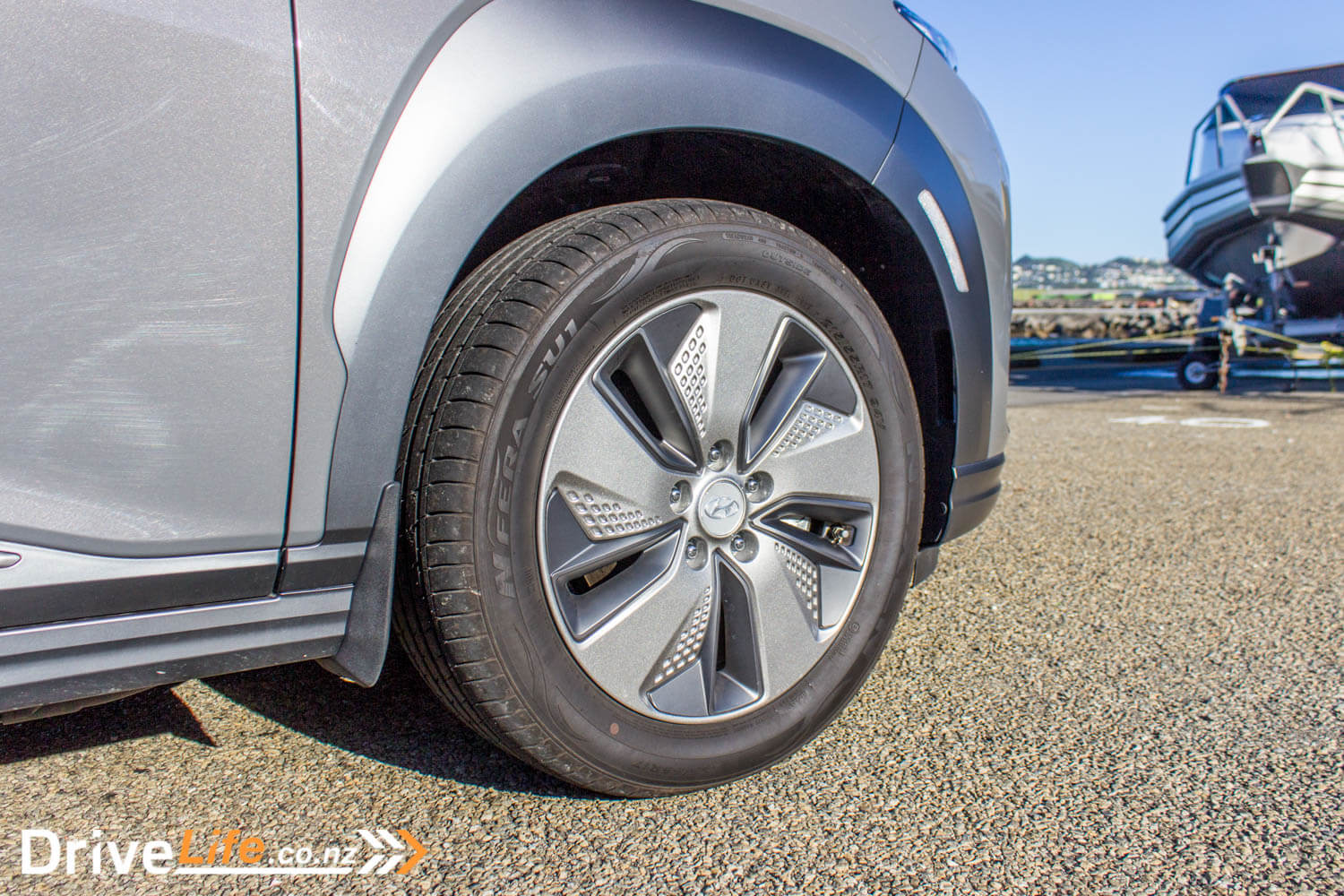
What’s The Interior Like On A 2018 Hyundai Kona EV Elite?
Luckily, they haven’t played with the interior too much, although the Kona EV is a euro-spec model, so there are some differences. The gearshift lever has gone, and in its place are four buttons to control the car; P, D, N, R. I think you can work out what they are for. It all looks very space age, and they work just fine, and certainly better than Toyota’s Prius with its funky gear shifter.
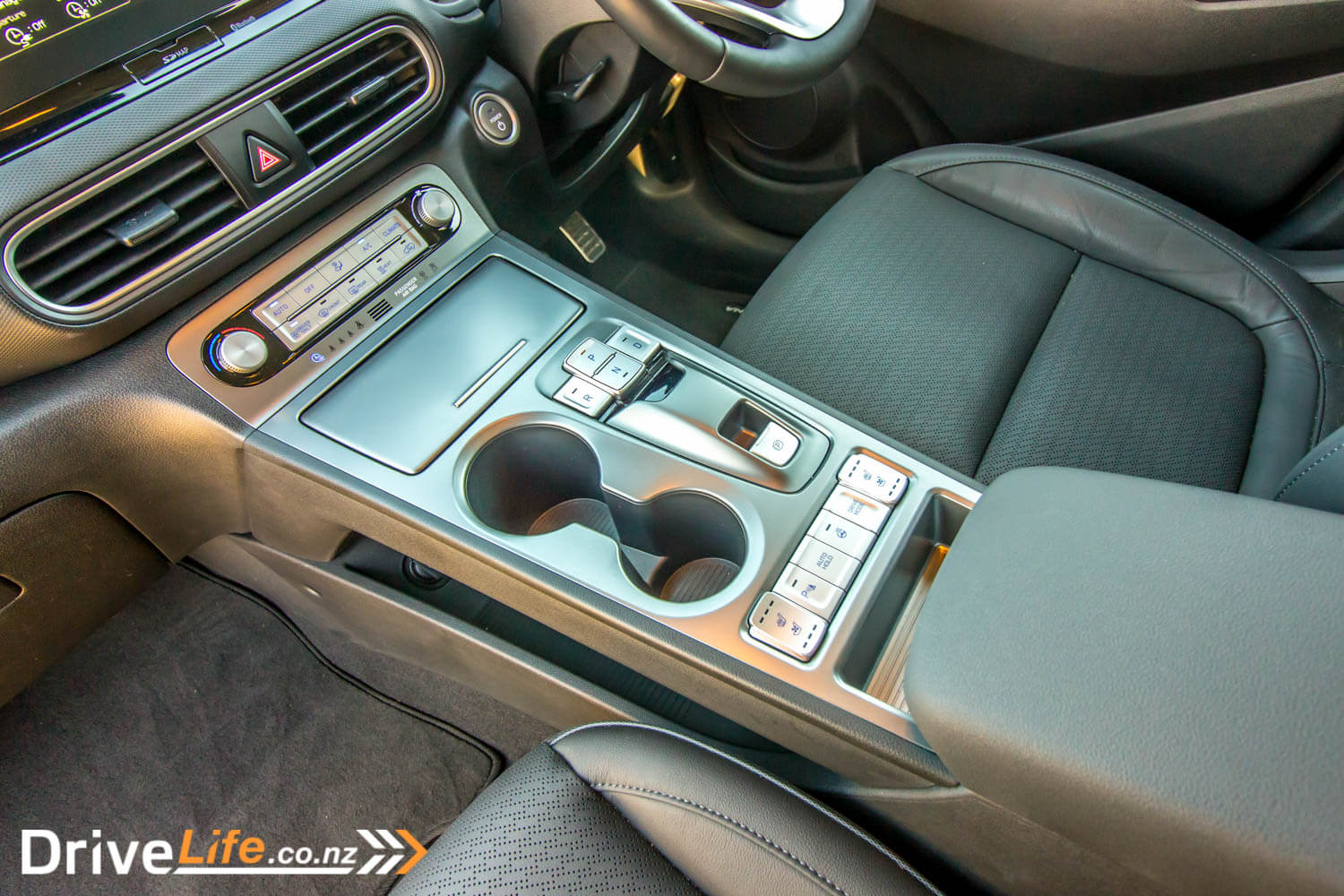
There’s a high centre console that’s split with an upper and lower level, a bit like the Honda HR-V. There’s lots of storage underneath as well as a good-sized cubby at the top-rear. You get two 12-volt sockets underneath, and then an AUX and a single USB on top. There’s also the Qi wireless charging pad right at the front on top, which can be hidden from view with a cover. That’s a nice touch, either for security or to reduce the temptation of reading messages while driving. I’m happy to say the Qi pad is flat – we’ve struck a few lately where they are on an angle, and this can stop the phone from charging, if the car hits a bump and the phone slides down.
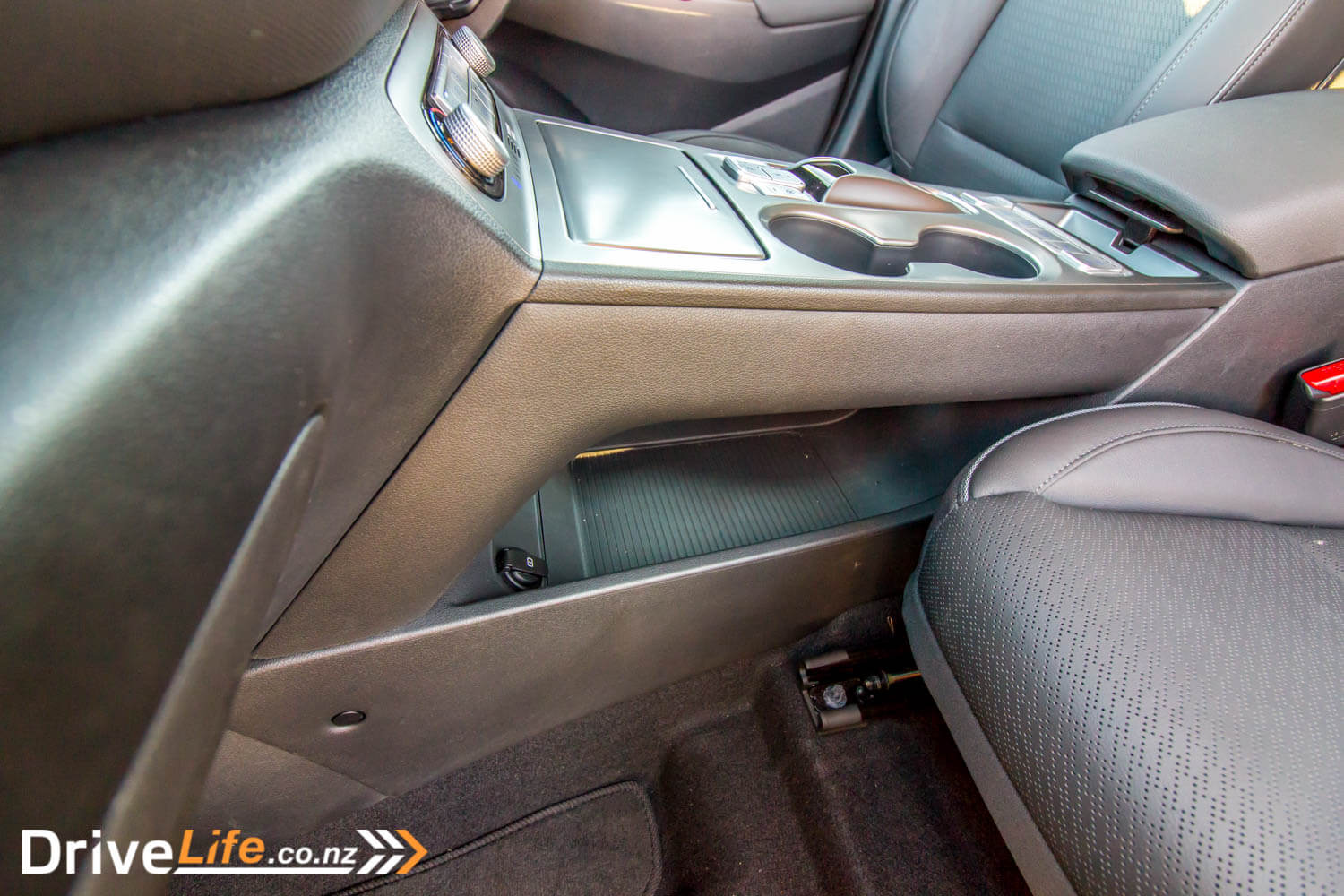
The end result is that it’s a nicer interior than the petrol version, although that high centre console can make it seem a bit smaller inside.
The seats and door panels are all black, while the headlining is beige, helping to break it up a little. There’s no sunroof, but the interior doesn’t feel dark.
For more details of the interior, check out the review of the petrol car.
I did notice one more thing that had disappeared; the petrol Kona has a space-saver spare, while the EV has just a tyre pump. Not the end of the world, and something we are seeing lots more of.
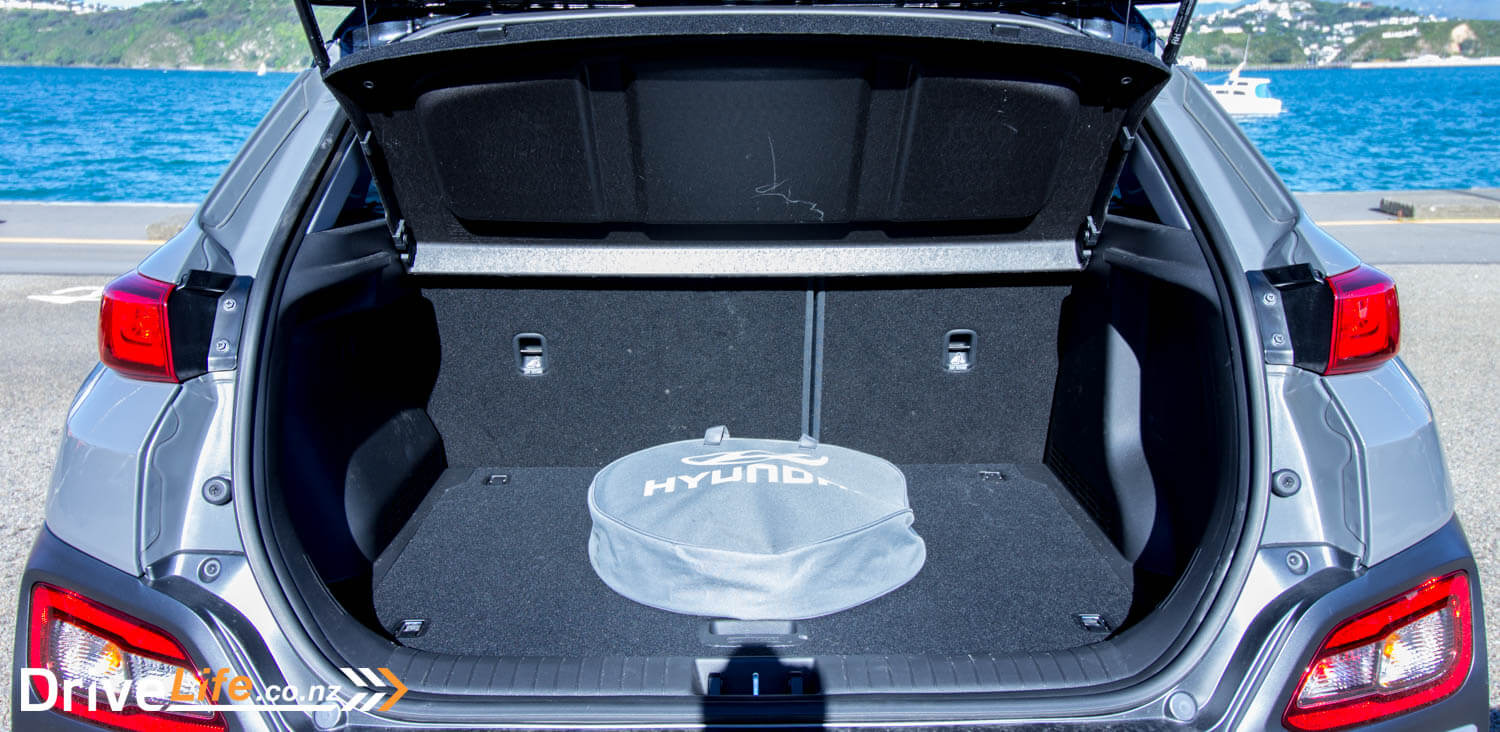
What Does The 2018 Hyundai Kona EV Elite Drive Like?
Even though I had jumped straight out of a Hyundai i30N and into the Kona EV, I put the wipers on after I had left the dealership – I would need to keep reminding myself this was a euro-spec car, and the indicators were on the left side of the wheel.
With 395Nm of torque in something as small as the Kona, performance should be excellent, and it is. This thing rockets away off the mark, even more so than the VW e-Golf we tested a short time ago.
The Kona EV has a HUD like one of the petrol models, and it’s still a ‘poor man’s HUD’, so it’s a piece of clear plastic that lifts up and out of the dash on a motor. Never quite as a good as a ‘proper’ HUD on the windscreen, but still usable. Hyundai does quite well with theirs, as it shows the current speed limit, if adaptive cruise is on, and blind spot monitoring.
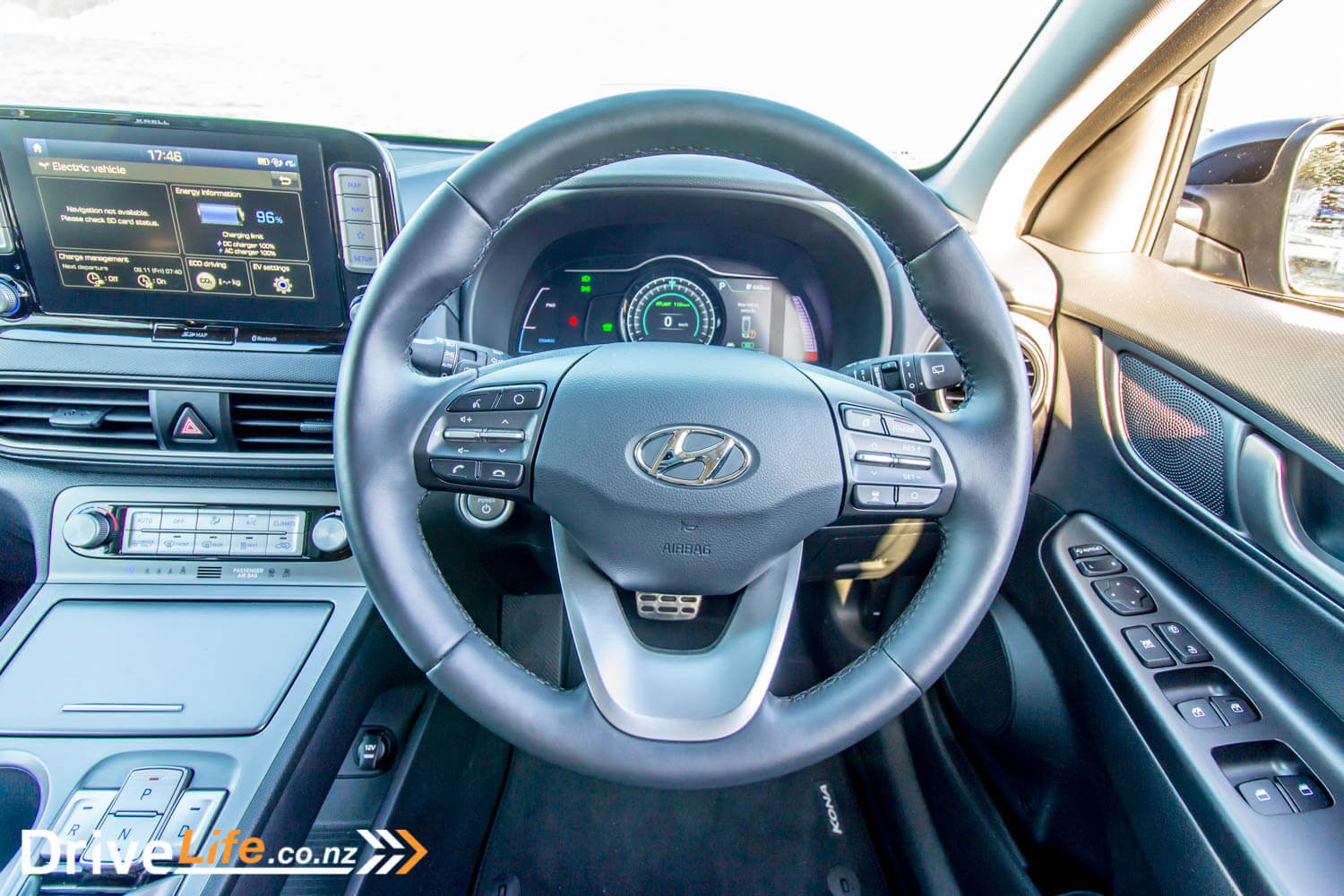
Even though our Euro-spec test Kona EV doesn’t have Satnav, it still has the option for it on the touchscreen, and also shows what we miss out on having, like apps for traffic, Live POI (Point of Interest), weather, parking, and locating charging stations. All handy stuff.
Since it was a hot day, I turned on the ventilated seat that the Elite model has. I like how Hyundai have integrated the heating/cooling into the one button – simply flick it one way for heating, or the other for cooling. We’re seeing this a lot more now, and it makes sense to use one button to do both tasks.
Visibility out of the car is excellent, with a nice big rear window taking up most of the rear view mirror.
I did notice at low speeds under say 25km/h, there’s an audible hum on the outside of the car to warn pedestrians of your Kona EV approaching. I’d like to say the sound is like a Tie Fighter from Star Wars, but that’d be a lie. In saying that, it does sound quite cool, and makes the car feel that little but futuristic as you hum along at low speeds. It certainly gets the attention of pedestrians but you can turn it off if you want to.
The fat and chunky leather steering wheel feels great to hold, and this was something I remembered from the petrol versions. I see that Hyundai also have a driver-centric air con option, similar to the one in the Prius Prime we tested recently. This focuses the air con to the driver only, saving on precious kilowatts of power. In fact, if the car is 100% charged and the range shown (450km), the range is also shown if you use air con the whole time, and it’s a mere 9km difference between the two numbers. Over a distance of 450km, 9km for using AC is showing just how efficient it is.
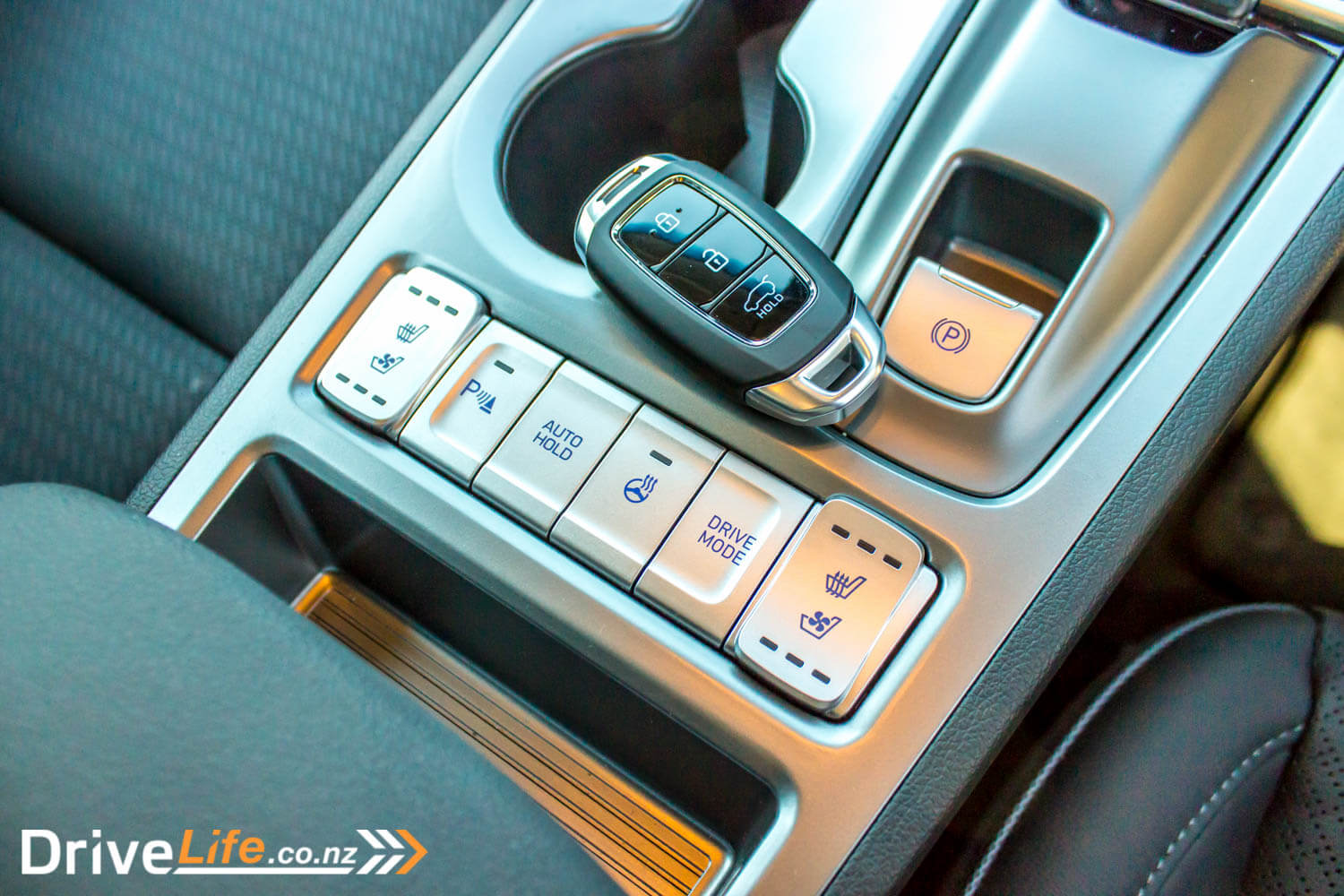
I took the Kona home, and it was down to 79% – time to plug it in for the night. The dash lights up with time left to charge when you plug it in, and told me it’d be 11 hours before completely full. This is a big battery to charge up from a standard 230-volt socket.
The next morning, we loaded up and left home by 730am – Auckland, here we come. I’d be driving the whole way to Auckland in Eco mode, just to be sure we were giving it the maximum shot at this. The boot is not tiny, but we managed to fill it quite well. This is a small SUV, but at least it hasn’t lost any of its 332 litres of space (with the back seat up) over the petrol model.
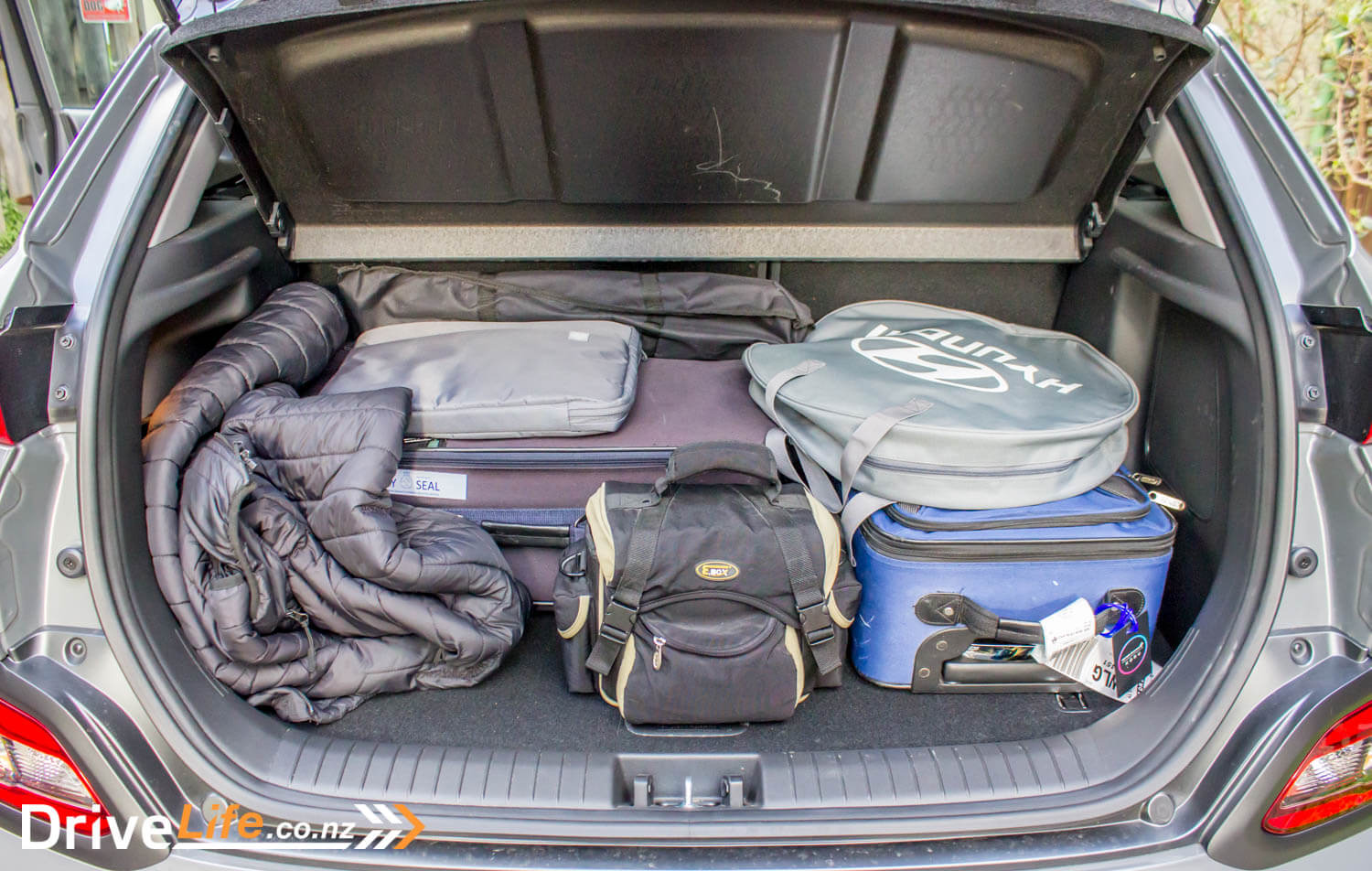
There’s four settings to alter your brake recuperation, and this is controlled by steering wheel paddles. It felt quite weird to use these to speed up or slow down, since they normally do a gear change. But it didn’t take long to get the hang of them – more regen as you approach a car to slow you down, then use the other paddle to ease off the regen and get ready to accelerate.
Even if you don’t use the paddles and have regen completely off, there’s an Auto Regeneration function which I guess uses the radar part of the adaptive cruise control, so if you are approaching a vehicle, the auto regen will kick in and turn itself on to slow you down and gain back more charge. With the drive mode set to Eco, you can see just how much charge you are getting back in the driver’s information display (DID). It’s quite interesting, and does become a bit of a challenge to see just how much charge you can get back down a hill, without going too slowly. My better amounts were about 2km, but your ‘average’ hill would see you get back less than a kilometre. Still, it’s free power.
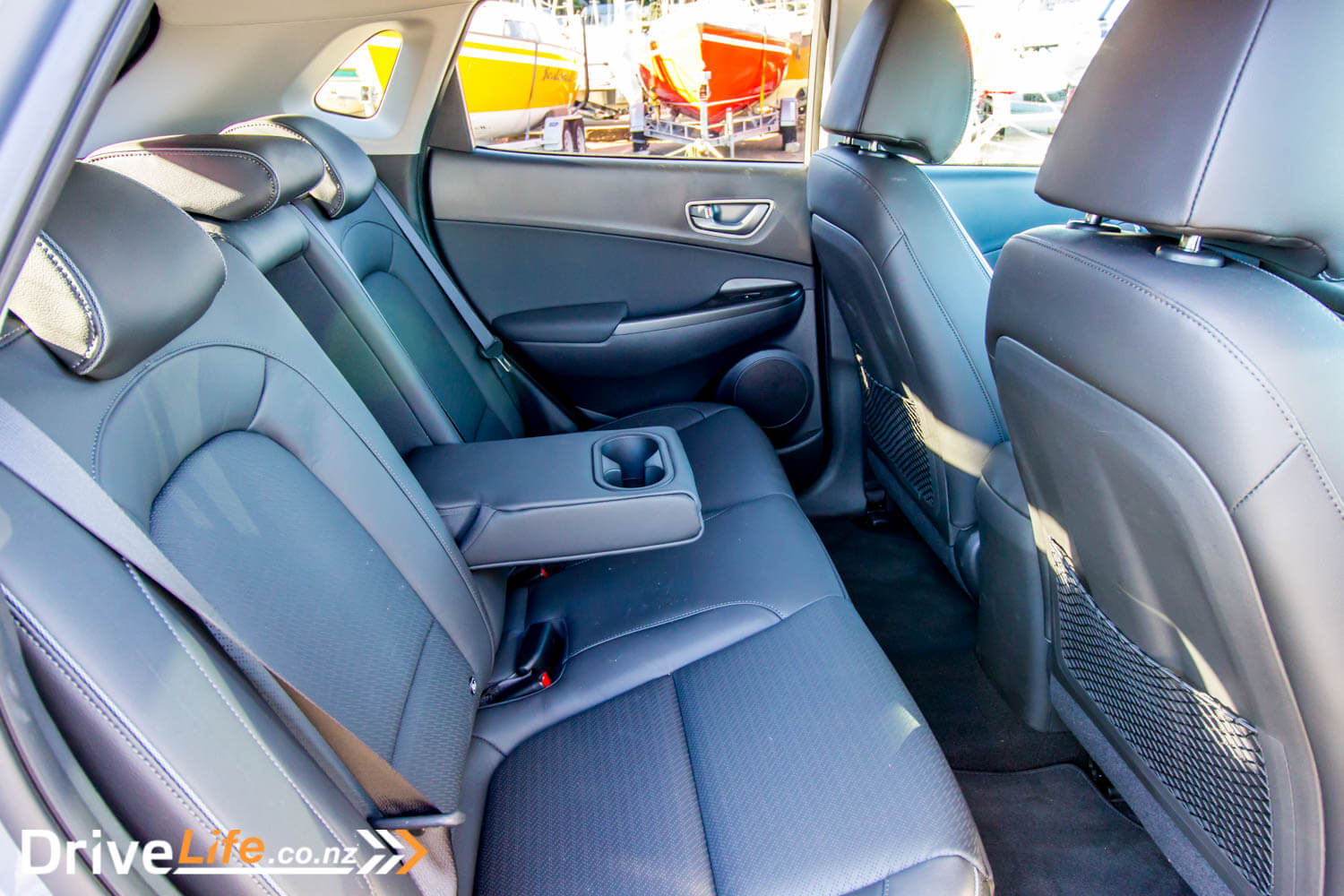
I don’t want to go on and on about the brake regen, but it’s a big part of driving the Kona EV. Sure, you could switch it off and leave it be, but it really packs a punch, especially when you have it on the max setting. Going down even a steep hill with max regen will see it almost stop. It’s the most severe amount of regen of any electric car I’ve driven.
Luckily too, the Kona EV remembers what regen setting you had it on when you get out of the car – get back in, and it still retains the setting. It does this for the drive mode too – leave it on Eco, and it remembers this every time you start the car. In fact, I drove the Kona EV in Eco almost all the time I had it. the performance is that good – yes, even in Eco mode – that it’s the best option.
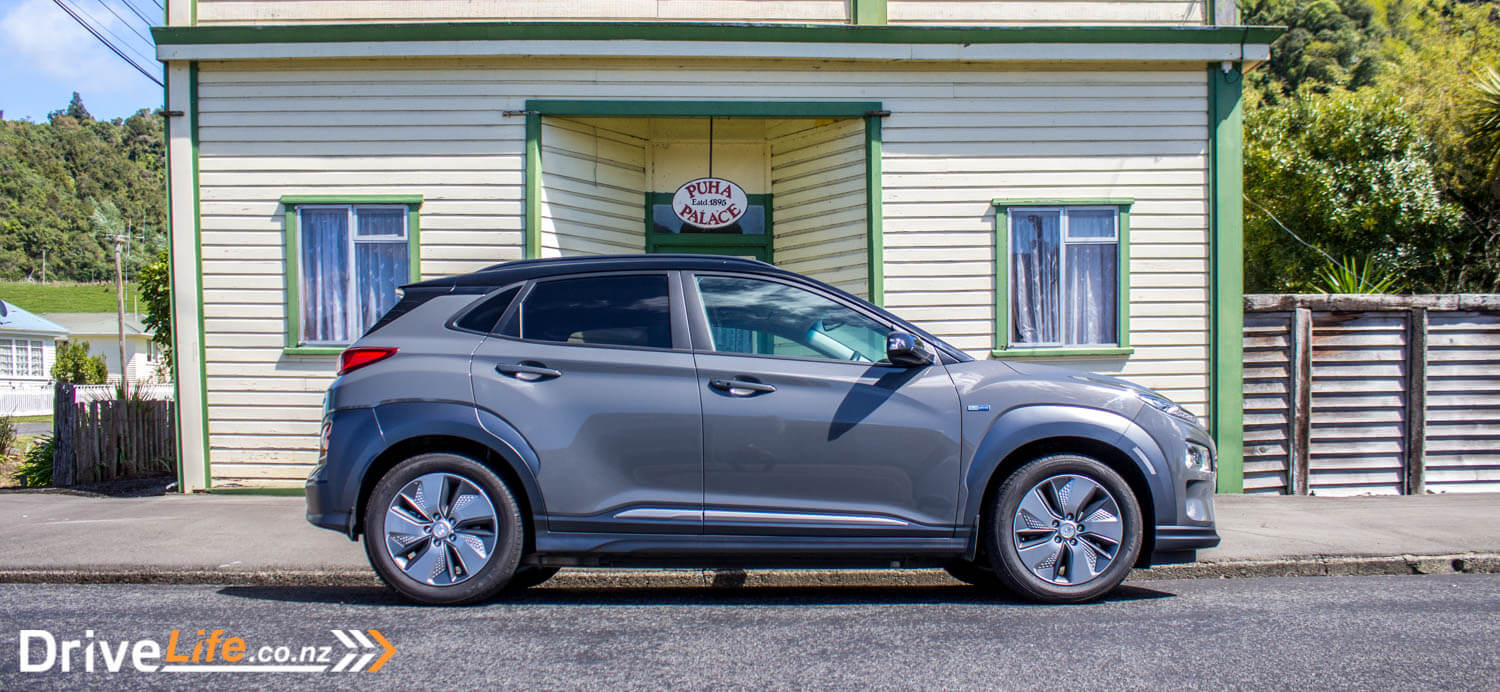
So while it remembers your brake regen and drive mode settings, the car doesn’t remember to turn on brake auto hold again, which is a shame. I had to keep remembering to turn this on again. One thing that does turn itself on every start of the car is the Lane Keep Assist. It’s a bit aggressive and would beep too many times for my liking – so I’d turn it off. But then when you got back in the car, it would turn itself on again. Not the end of the world, but one of those slightly annoying things.
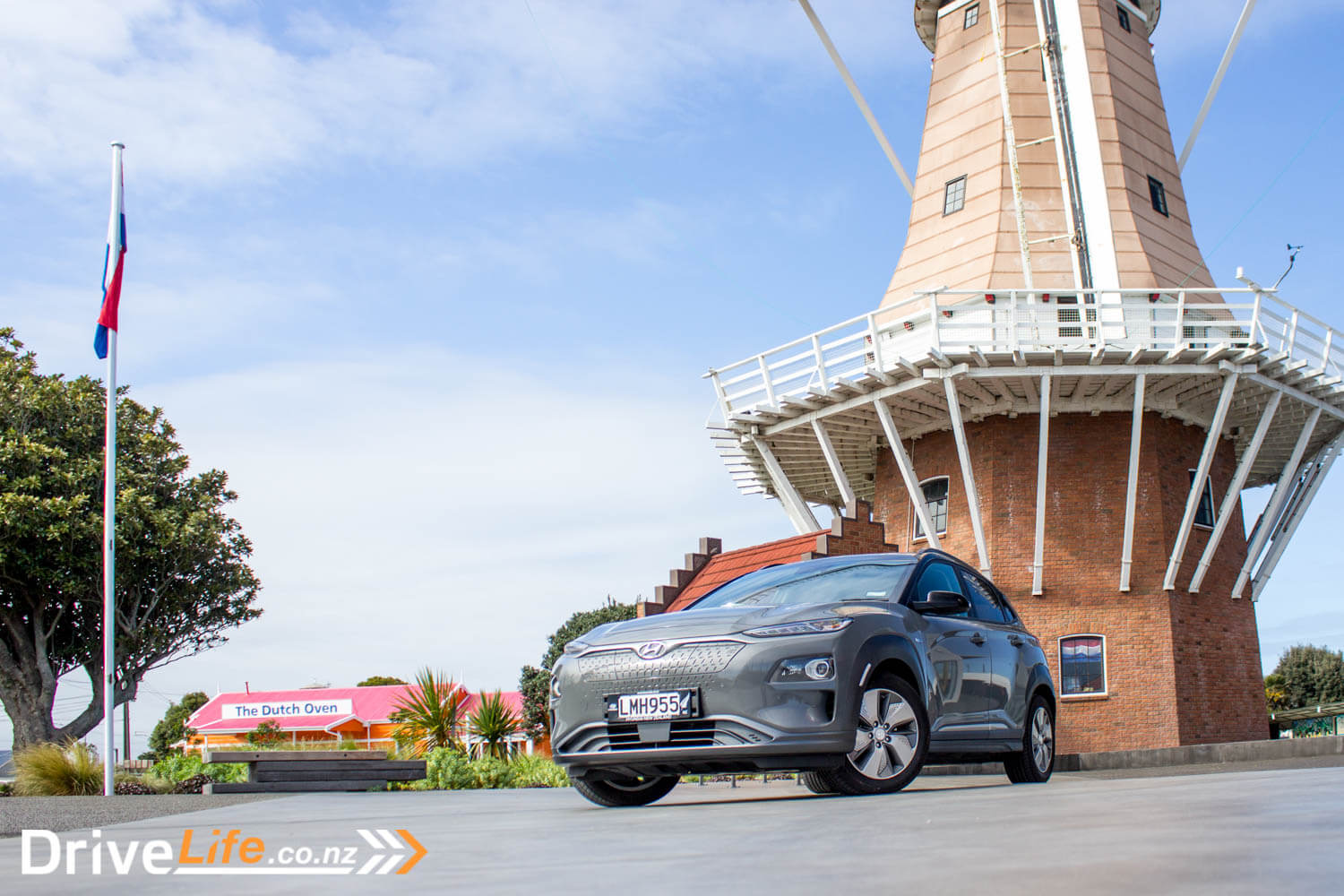
Anyway, back to the drive. We cruised North, with a plan to get to Taupo and have lunch. Hyundai say the Kona EV has a ‘real world’ range of 400km. Taupo? That’s 363km from my house. We got closer and closer, passing through Waiouru, and hit the Desert Road. The corners and hills took their toll on our range, and while we had 50km left in the ‘tank’ and 60km to Taupo, my wife called it and we stopped in Turangi. I was keen to push the car as far as it would go, but those people who know what I mean know that sometimes it’s easier to just go with it.
We pulled into the Charge Net station behind the Z in Turangi, plugged the car in and I kicked off the charging on the app on my phone. Both the charging station and my app told me exactly how long it would be to the magical 80% charge – 50 minutes on the dot. Why not 100% charge? To get to that would take almost 2 hours, so many EV drivers charge to 80% and call it quits (on a fast charger). Most charging stations are setup for this very number. You can charge to 100% but most will assume you want only 80%.
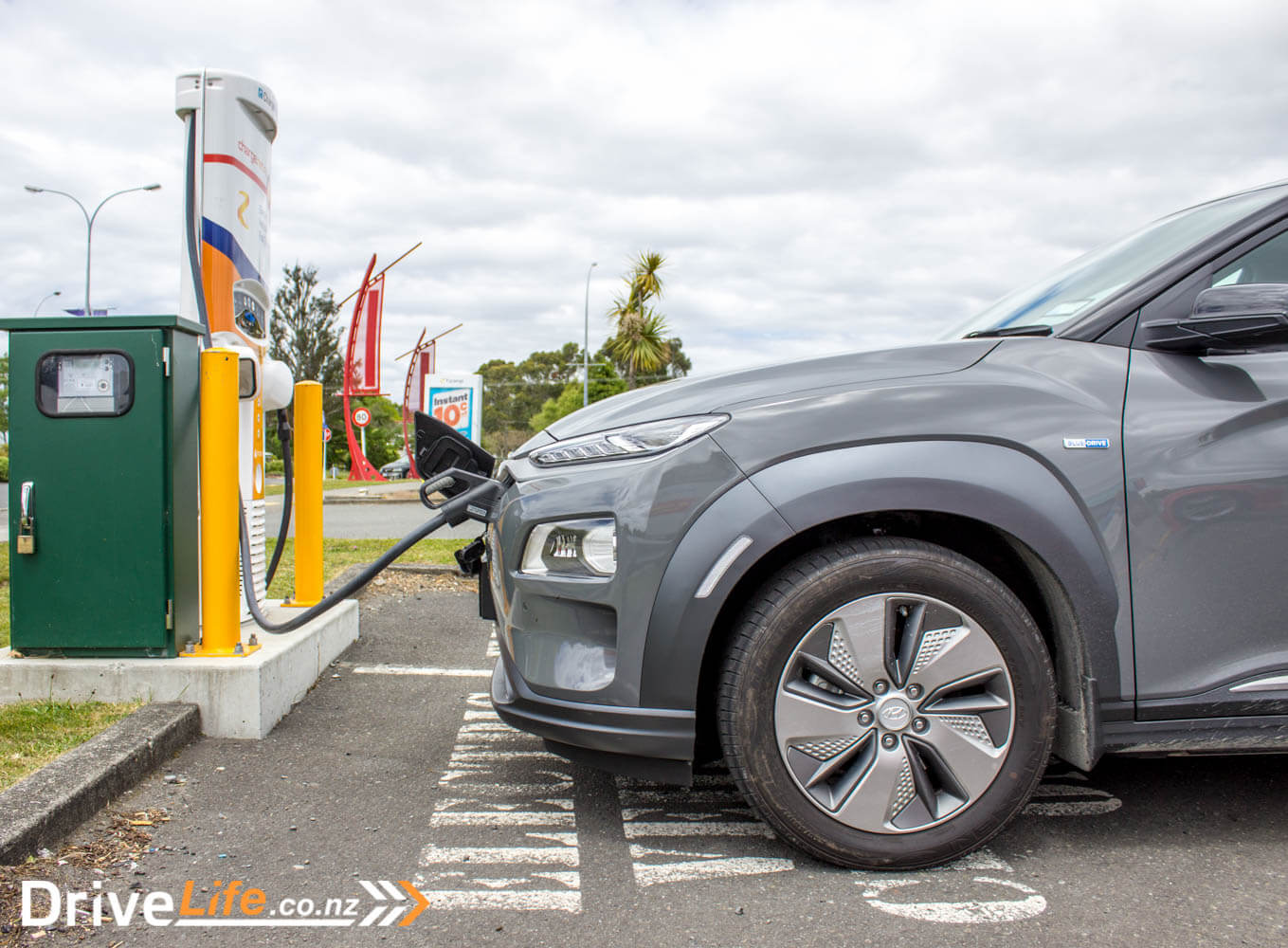
So Turangi – that’s 330km from home, and we had 50km left in the car – not too far off the promised 400km, and we did go up a lot of hills. While you get some good regen when going down a hill, going up uses a whole lot more – there’s no free lunch with an EV and hills.
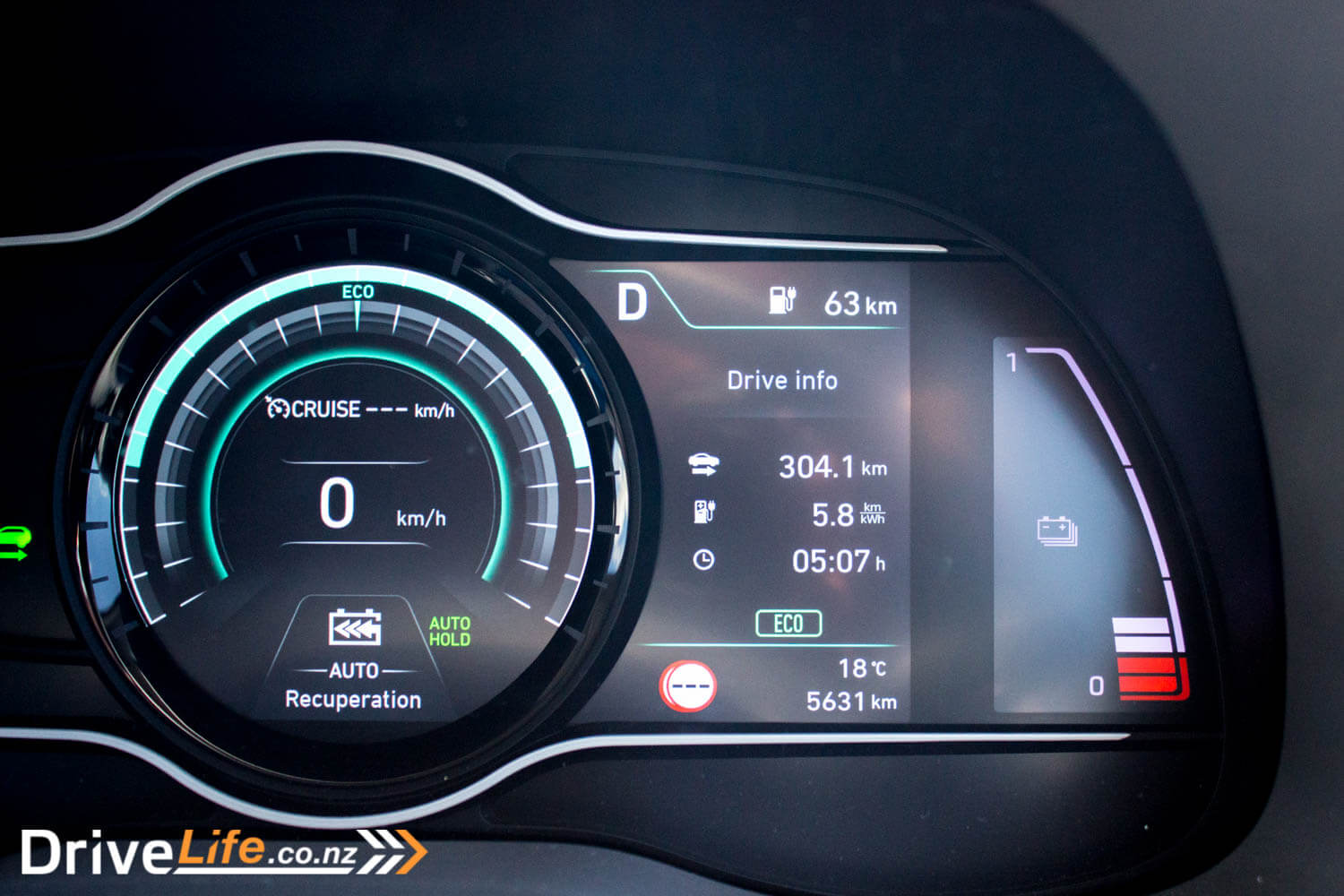
We went off and had lunch in Turangi, while I kept an eye on the app. Charge Net generally charges 25cents/kW and 25cents/minute charging time – so yes, it can add up quickly. In saying that, once lunch was over and the car was charged to 80%, I got a text to say I’d been charged $26.70. I’d like to say that means it cost $26.70 to get the 330km to Turangi, but keep in mind that’s a charge to 80%.
We motored out of Turangi with 340km of range, and a 327km drive to our destination in Auckland.
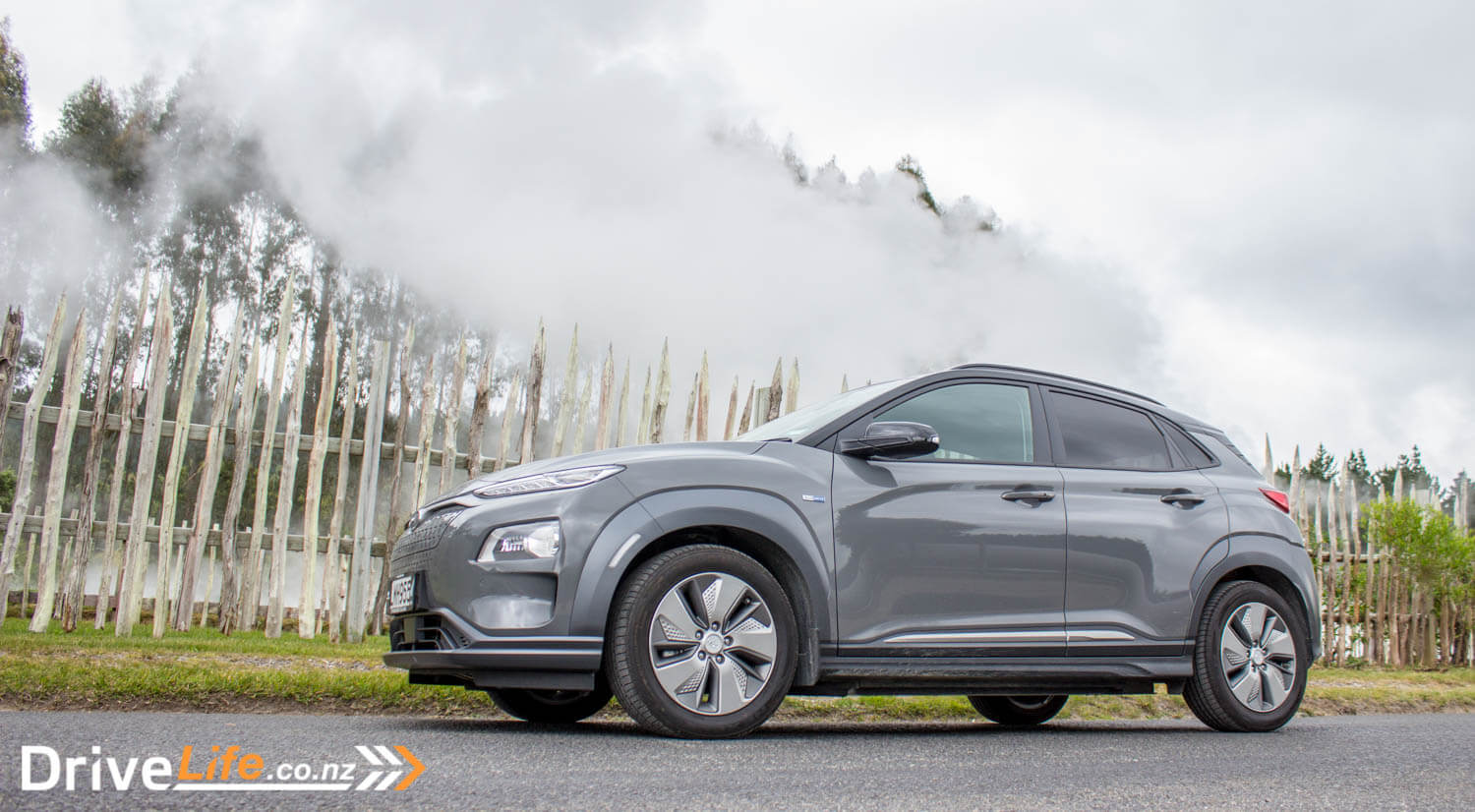
I really like the adaptive cruise control in the Kona EV; they seemed to have refined it and developed it for the EV, and it’s one of the smoothest systems I’ve used. It will take you right down to a stop – great for road works – and then get you going again with a touch of the ‘gas’ pedal, or a flick on the adaptive cruise switch. It even gives you a nice little reminder on the dash of how to move off again.
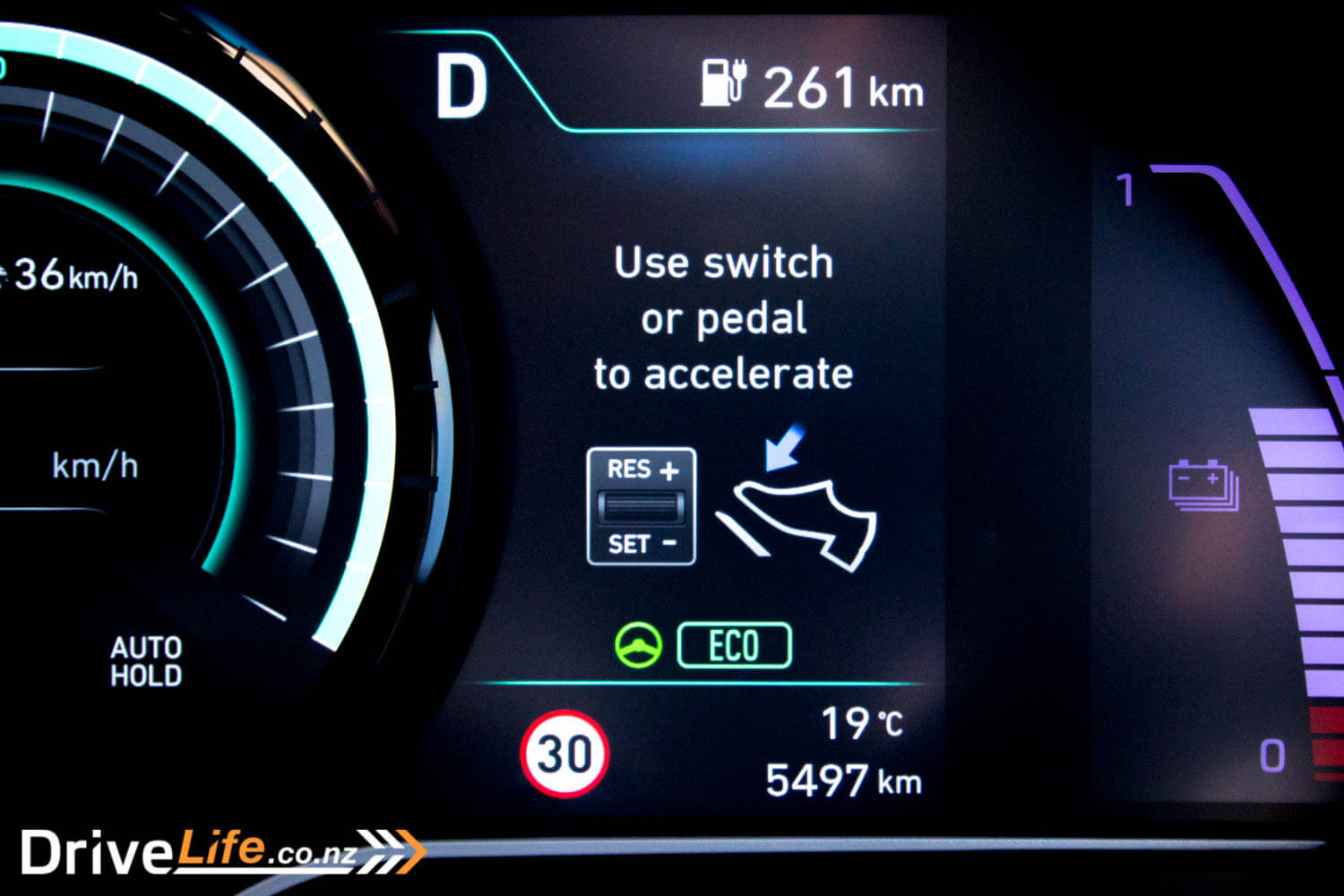
While I was trying to conserve energy (honestly!), I still marvel at the acceleration of the Kona EV. With 395Nm of torque, this thing can really fly. It surprised people when you pass, simply rocketing past anyone with zero noise. Hell, if you have it in Sport mode and floor it at 60km/h, it will spin the front wheels in the dry. As far as performance goes, this is a grin-worthy drive. I expect some people will buy the car after driving it not because it has no engine noise or to save money, but because of the effortless performance.
The drive went on, after about 7 hours of driving, I could feel the seats were up to the task. While you only get 2-way electric lumbar adjust for the driver, the seat cushion is not too bad for the long haul. The side support too is very good, especially handy since you can pretty much throw the Kona EV at corners. I found it hard to make the tyres squeal, or lose grip – and remember this small SUV does weigh in at 1,700kg and is only front-wheel drive. All that low-down weight really helps in the handling department, and it sits quite flat on the corners.
Even in the wet there’s quite a bit of grip.
I note that the Nexen N’Fera SU1 215/55/R17 tyres fitted to the Kona EV are not hard-compound, super fuel efficient tyres – they are just run of the mill tyres. That’s the first time I’ve seen a eco car without such a tyre.
As we got closer to Auckland, my wife chickened out again, and we pulled into Hampton Downs race track to get a free charge at the fast charger supplied by WEL Networks. I found this charge station on the Plug Share app, and couldn’t believe it was free! We went to grab a coffee at the cafe at the race track, but were too late. Bummer. This charge took 20 minutes to get to 80%, and we hit the road again for Auckland.
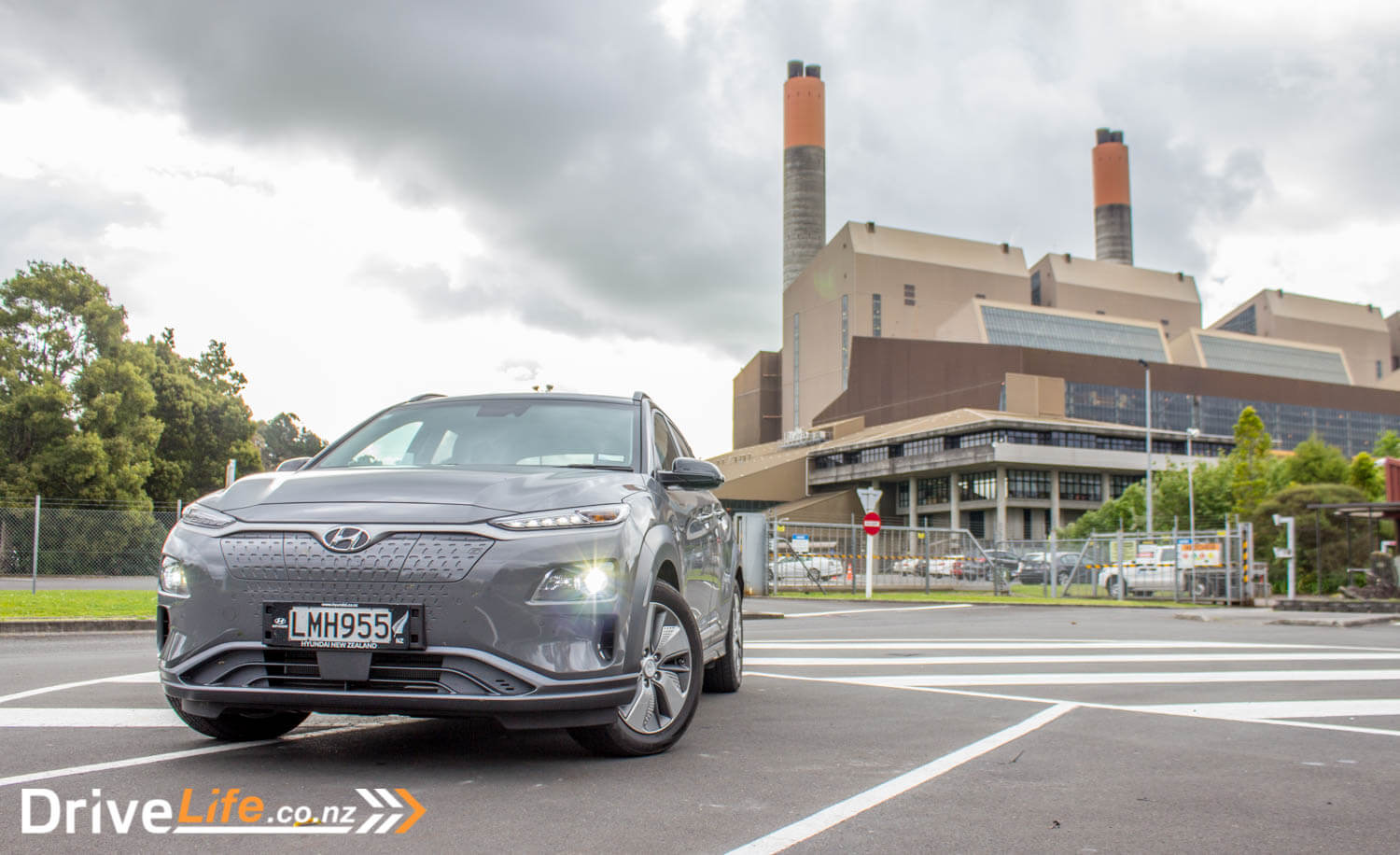
So – how long did it take? With our two stops for charging, 13 hours. Yes, that’s longer than if we had driven a petrol or diesel-engined car, but honestly, it wasn’t bad. Did I hate wandering around Hampton Downs having a nosy at everything? No way. A 50-minute lunch in Turangi? There’s worse things than that.
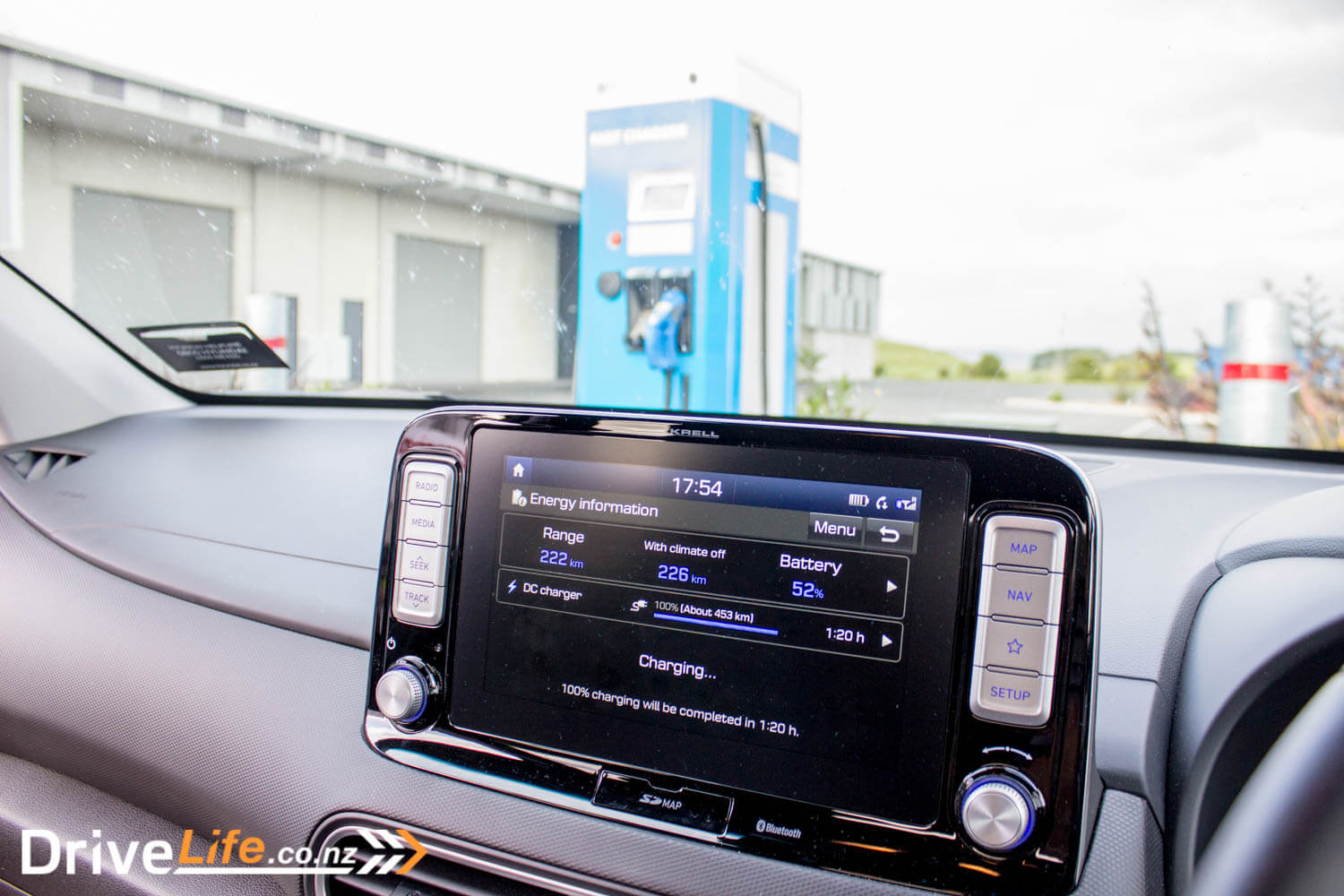
There’s the other benefits too; we’ve tested electric cars before, but mainly around town. While it was strange having no engine noise on the open road for 600km, it was a pretty pleasant way to travel. You do hear a lot more tyre noise – the Kona EV does not like coarse-chip seal at all – but conversations and general travel is that much easier. That’s not to say petrol or diesel cars are noisy – most modern petrol or diesel cars are almost inaudible at motorway speeds, but it was the constant silence that was the difference.
We arrived in Auckland, the car telling me that driving in Eco Mode so far we had achieved 6.6km/kilowatt-hour. We did what we needed to do in Auckland the next day – driving around, and charging up a little at friend’s house overnight, then it was time to hit the road again. This time, I was going to drive in Normal mode all the way home.
We didn’t charge the car up completely, so choose to stop at Hampton Downs again and wop it up to 80%. This time, the café would be open. The Go Karts would be open too, but there wasn’t enough time for that – this trip.
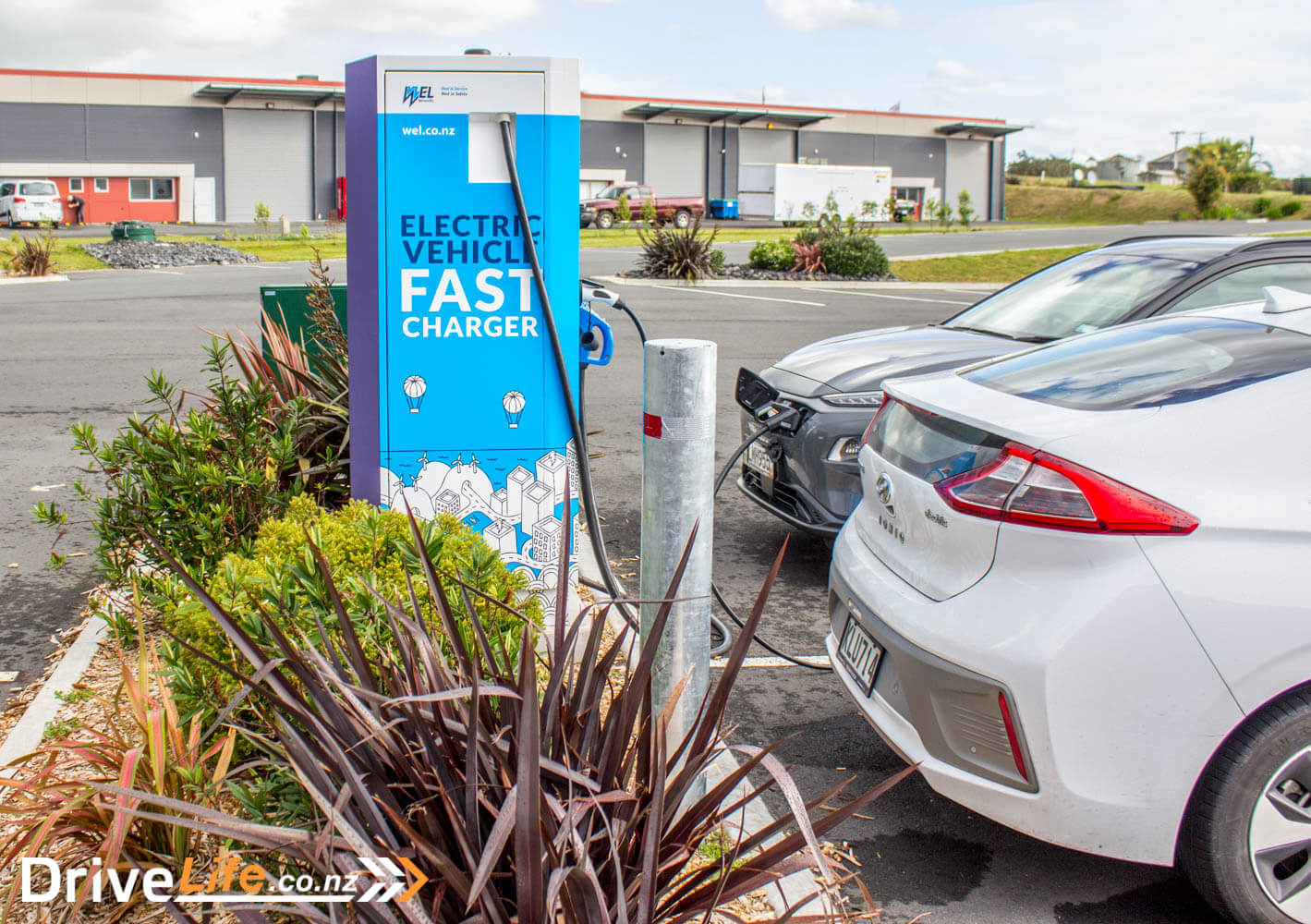
Then we decided we’d stop in Taupo for lunch – and see some friends there – and charge up again, this time at another Charge Net station that was owned by electric company, Unison. The charge for this one would be a flat 40cents/kilowatt – so no charge for the time it would take.
With our battery on 30%, I pulled in – nose first of course – and then plugged the cable in to charge, got my phone out and kicked off the charging. And then the charge stopped. I did this four times, then rang up Unison (who answered very quickly), and they suggested I call Charge Net. I did that – they too answered in a few seconds. After hearing what was happening, they kicked the charge off at their end, and the amps flowed. After talking to the tech guy there, it sounds like I had selected the wrong cable type – more on that soon – so likely it was my fault.
We duly went off for lunch, and one and half hours later (yes, I know) we went back to the car to hit the road, only to see that the charging had stopped for some reason at 64%, at a cost of $8.32
We didn’t want to wait to try again, so left Taupo and headed straight to Turangi – we knew if we charged up to 80% there, we’d make it home. It took 20 minutes to get the charge from 55% to 80% (at $11.08) and we left again. We had 345km of range leaving Turangi, and a 330km drive home. It was going to be close, so I switched the car to Eco mode, to be safe.
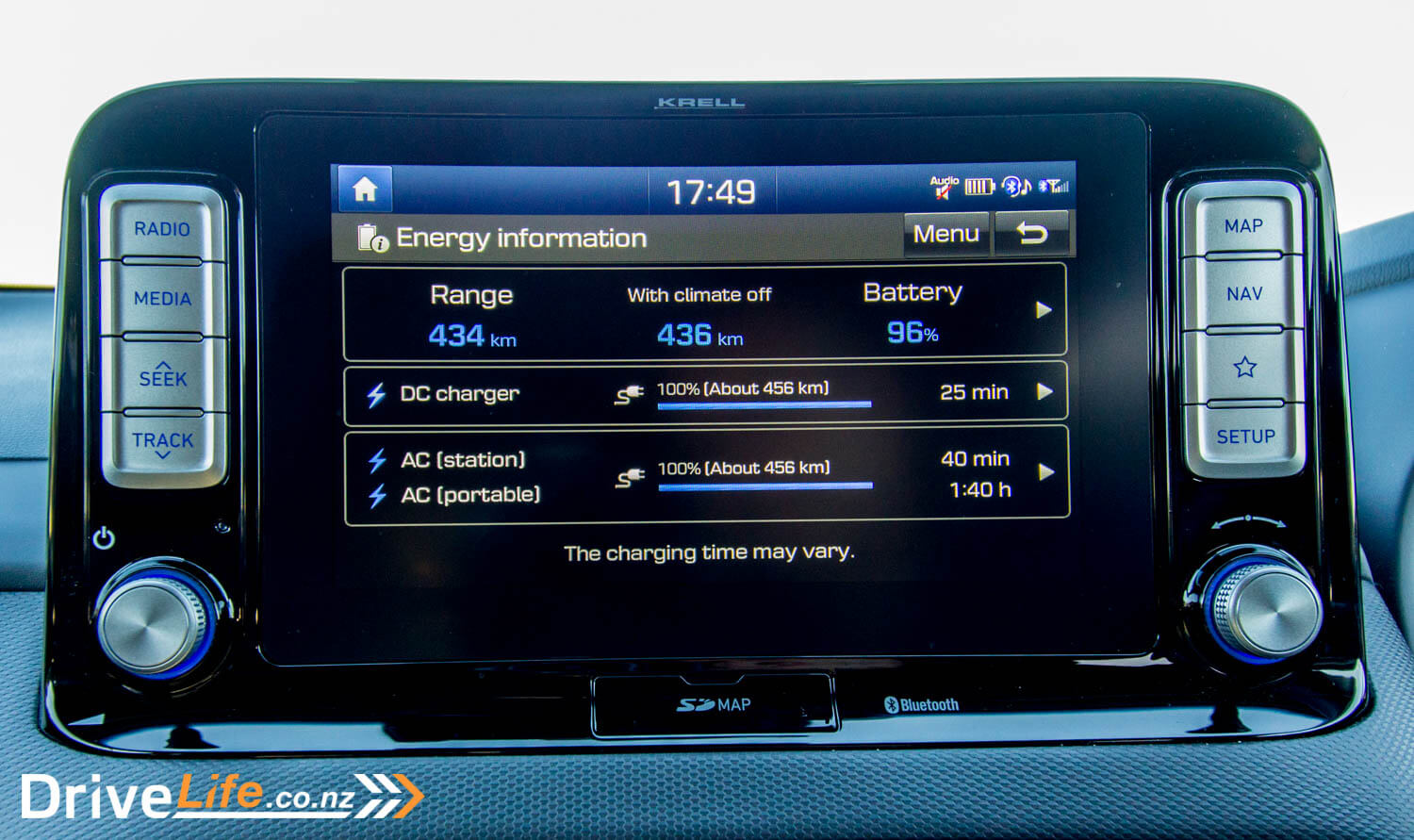
The ride home from there was uneventful, although I kept a close eye on the battery range. We made it with 13km left in the battery (4%), so that was a relief. The return trip with our extended lunch was another 13 hours, but it actually made it less stressful – having breaks more often was quite nice, and I’d do it again. There’s no real need to be in Auckland in 8 hours, or else…or else nothing. It was good to take our time, and for some reason we even managed to do a few side trips for the hell of it, like going into Foxton township, and then a tour of the back streets of Mangaweka – it was worth it for Mangaweka, especially. Lots of old-school character in that little town.
So we did it, without too much stress, Wellington to Auckland and back. Range Anxiety? Not really. With some good apps on your phone and a bit of planning, it was a more enjoyable trip than driving a petrol or diesel car – and I’d do it again tomorrow. Yes, it took longer. But I don’t care – it’s hard to be annoyed with a car with such great performance.
Over my week and 1500km of driving in the Kona EV, I managed 6.7km/kW.
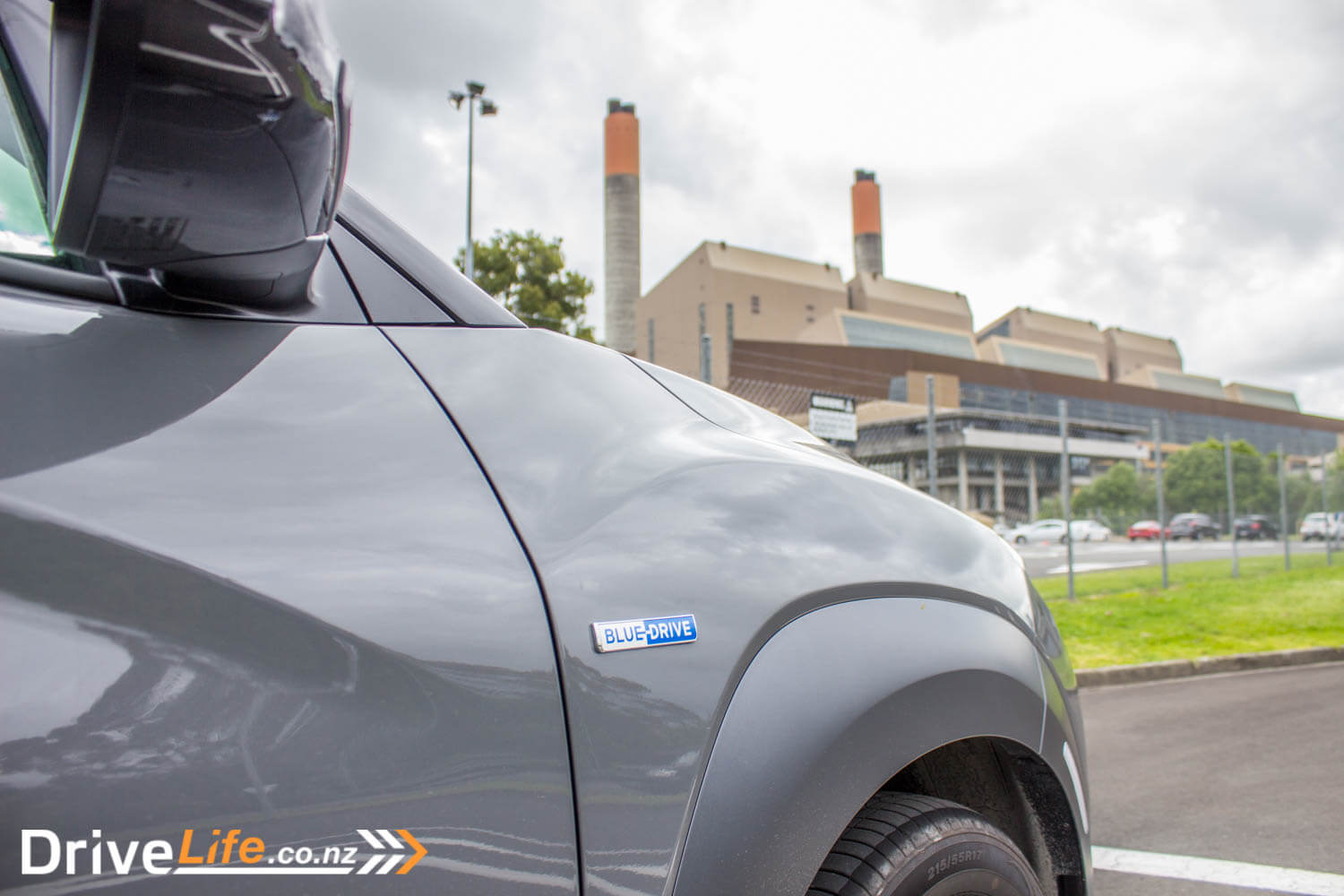
What’s The Competition For The 2018 Hyundai Kona EV Elite?
| Brand/Model | Power/ Torque |
Est. Range, km | kWh/100km | Battery capacity, kWh |
Seats | Boot space, litres |
Price |
| BMW i3 | 125kW/250Nm | 200 | 33.0 | 5 | 260 | $77,200 | |
| Hyundai Kona EV Elite | 150kW/395Nm | 400 | 14.3 | 64.0 | 5 | 332 | $74,900 |
| Renault Zoe | 68Kw/220NM | 400 | 41.0 | 5 | 338 | $68,990 | |
| VW e-Golf | 100kW/290Nm | 220 | 35.8 | 5 | 341 | $62,990 |
What’s The Pros And Cons For The 2018 Hyundai Kona EV Elite?
| Pros | Cons |
|
|
What Do We Think Of The 2018 Hyundai Kona EV Elite?
Let’s get it out there – the top-spec 1.6-turbo petrol Kona Elite is $41,990 – the Kona Elite EV is $79,990. You aren’t going to buy a Kona EV over the petrol version to save money. But if you are an early adopter and want the range without the cost of a Tesla, the Kona EV is a great option – potentially the only option if you really need that 400km range.
Keep in mind too, Hyundai’s own Ioniq Elite EV is near on $66,000 with its 28.5kw battery pack.
If you travel long distance regularly and can’t afford to take your time to charge up here and there, and can’t afford a Tesla with its longer range – then stick to a petrol or diesel SUV or car for now.
But we do need to keep in mind the average driving distance for a New Zealand car per day; 27km. That’s it, 27km. The Kona EV will do most of what most of us need, comfortably and very quickly – not to mention quietly.
Initially I balked at the cost of the Kona EV when the pricing was released. Since then, Hyundai have been claiming that this will be New Zealand’s top-selling EV.
After driving it long distance, I think they might be right.

2018 Hyundai Kona EV Elite rating: 4.5 Chevrons
2018 Hyundai Kona EV Elite – Specifications
| Vehicle Type | 5-door electric small Crossover SUV |
| Starting Price | $74,990 |
| Price as Tested | $79,990 |
| Engine | Electric, driving front wheels only |
| Power, Torque | 150kW/395Nm |
| 0-100km/h, seconds | 7.1 |
| Spare Wheel | Pump |
| Kerb Weight, Kg | 1685-1743 |
| Length x Width x Height, mm | 4180x1800x1570 |
| Cargo Capacity, litres Seats up, seats down |
332/1,114 |
| Battery capacity, kWh | 64.0 |
| Towing Capacity Kg, unbraked/braked |
n/a |
| Turning circle, metres | n/a Small: 6-10m / Medium 10-12m / Large 12m+ |
| Warranty | 3 years, 100,000km warranty 3 years, 100,000km Roadside Assist 10 year/unlimited km battery warranty |
| ANCAP Safety Ratings | 5 Star |
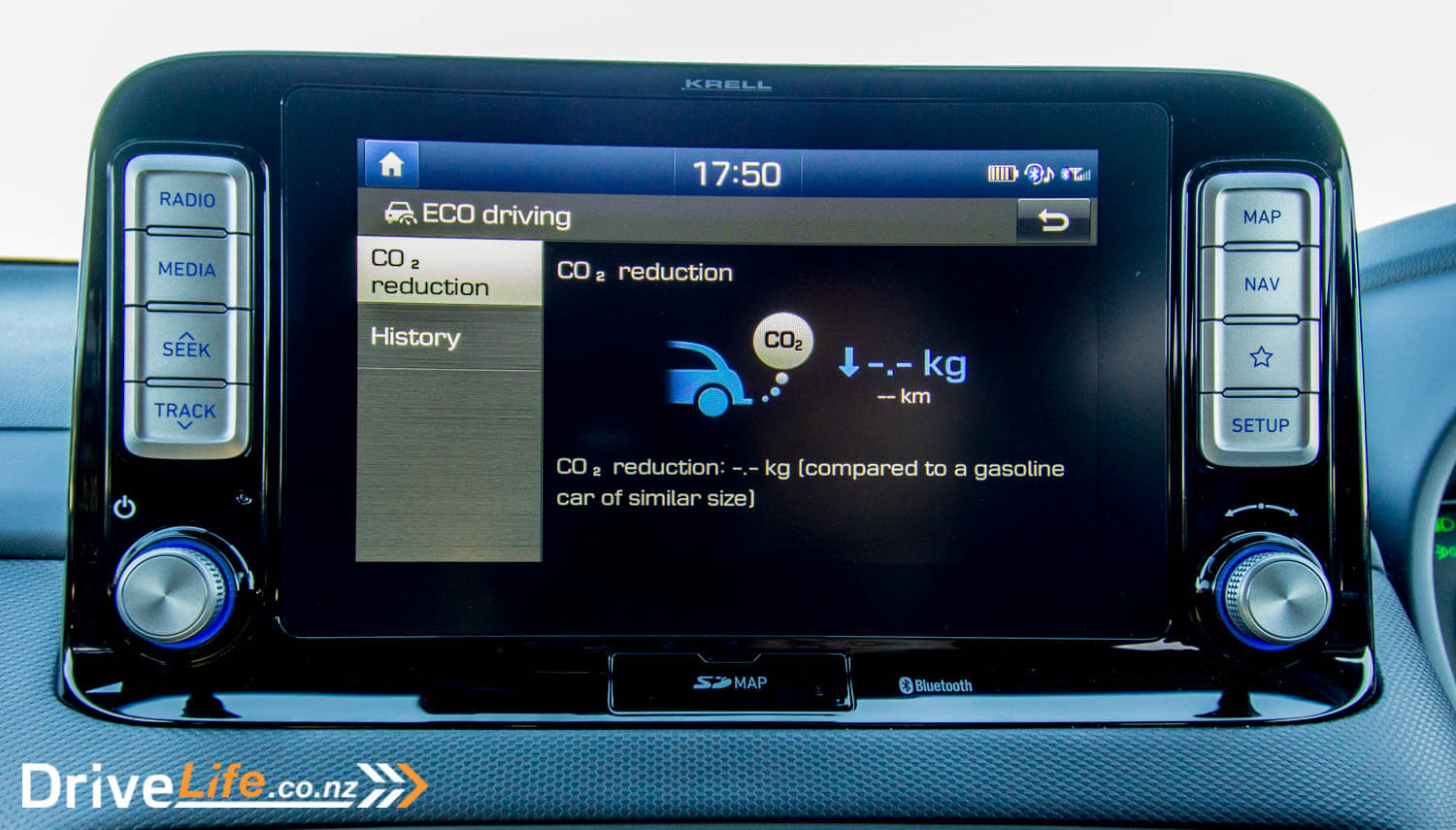
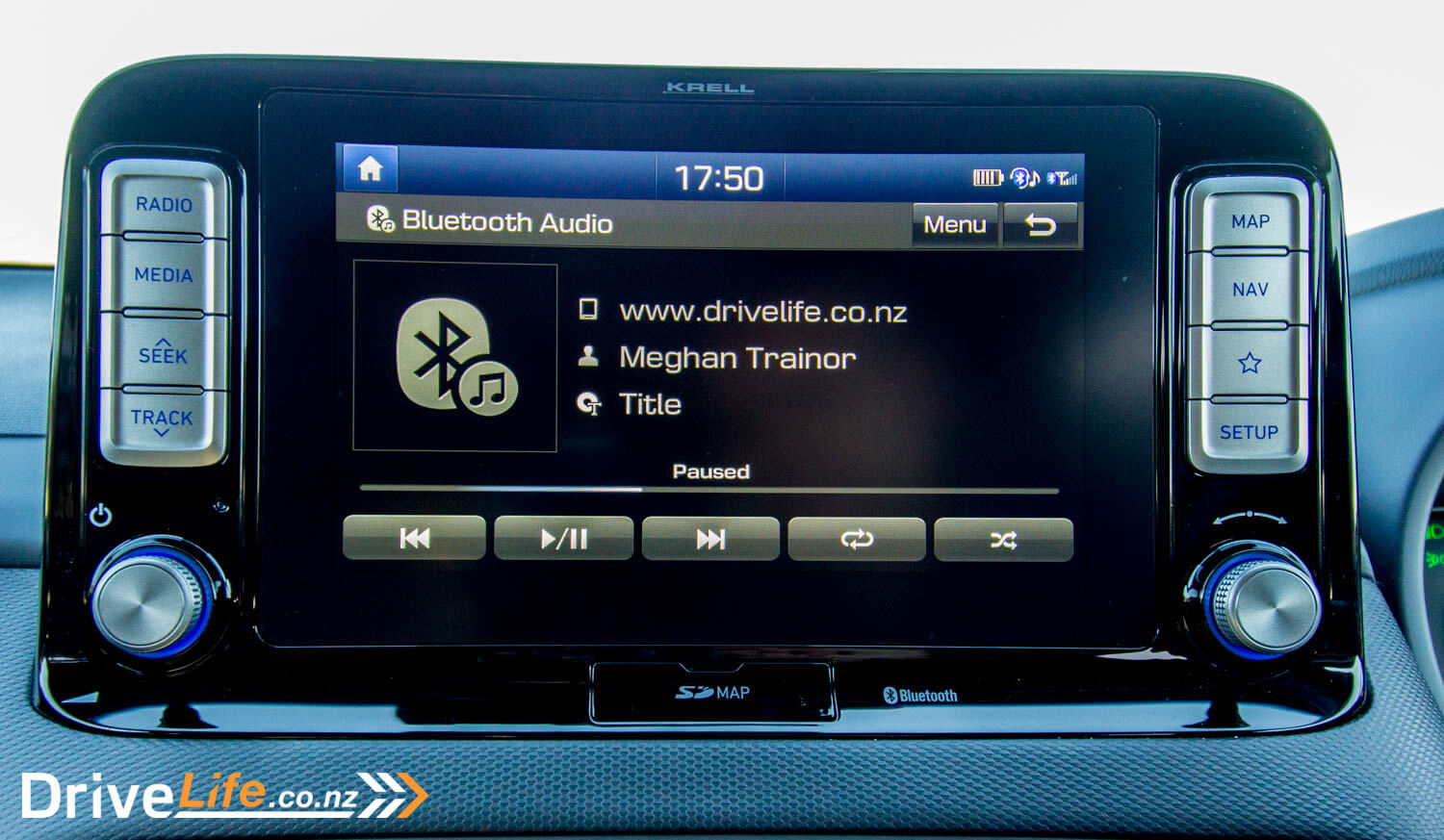
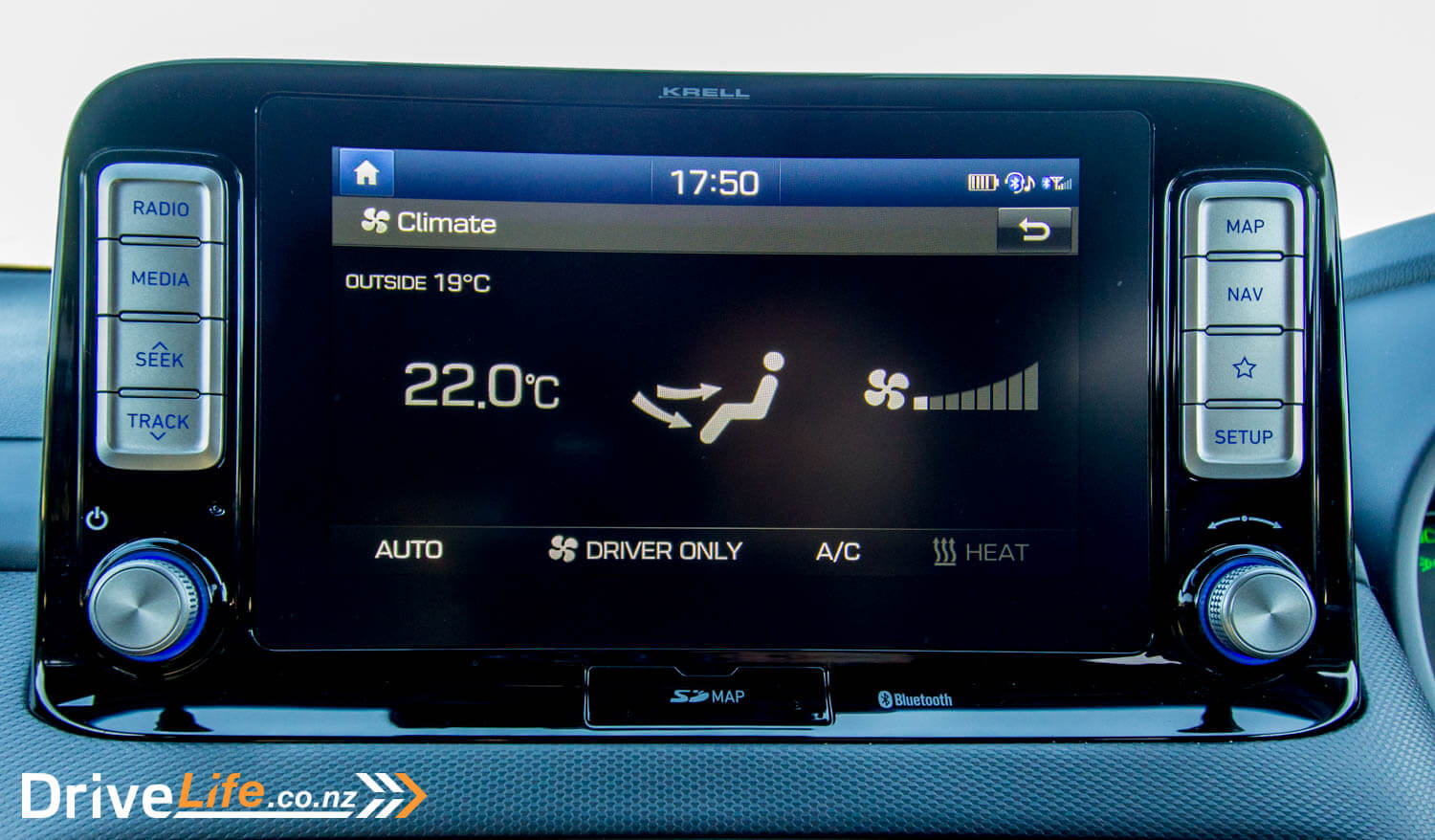
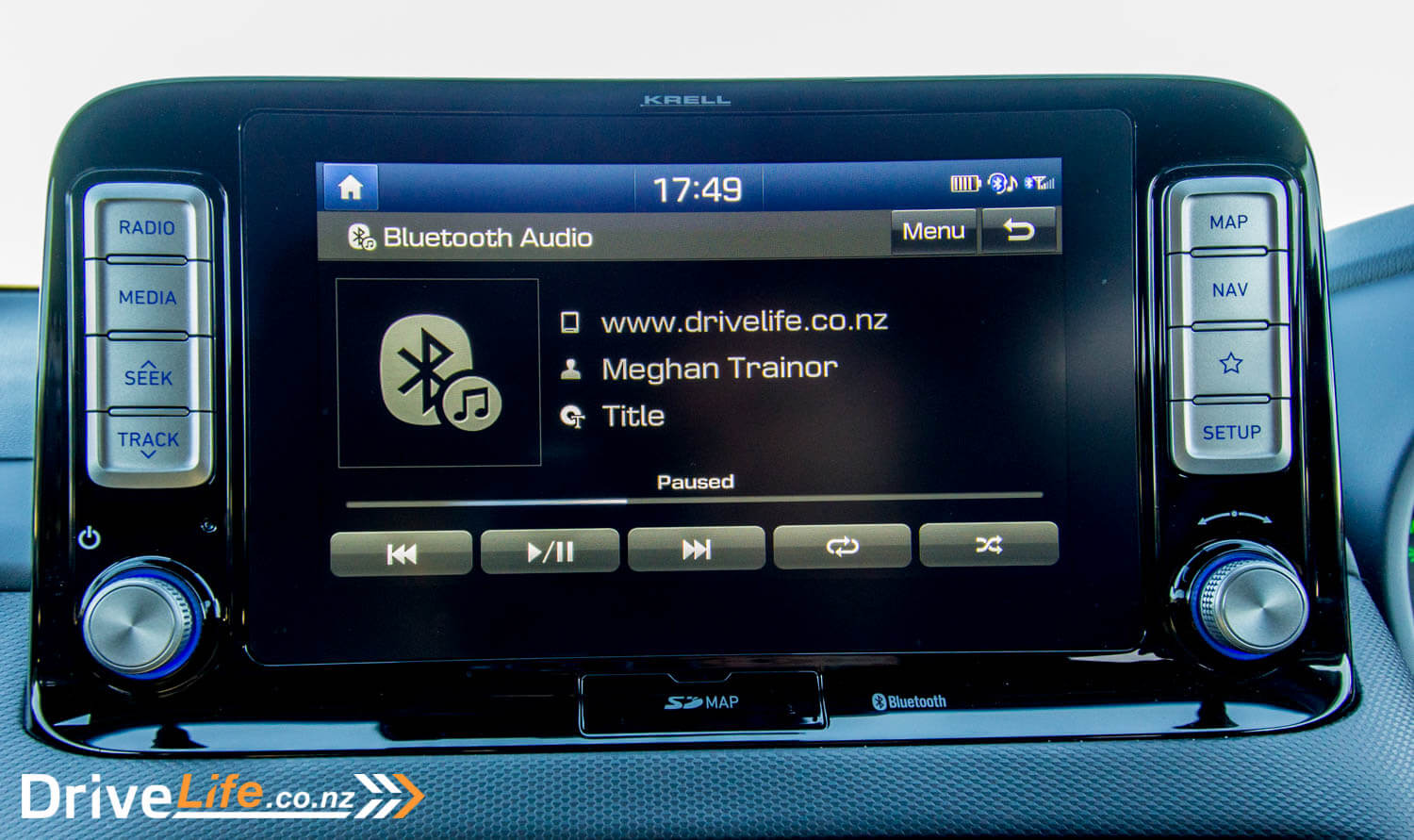

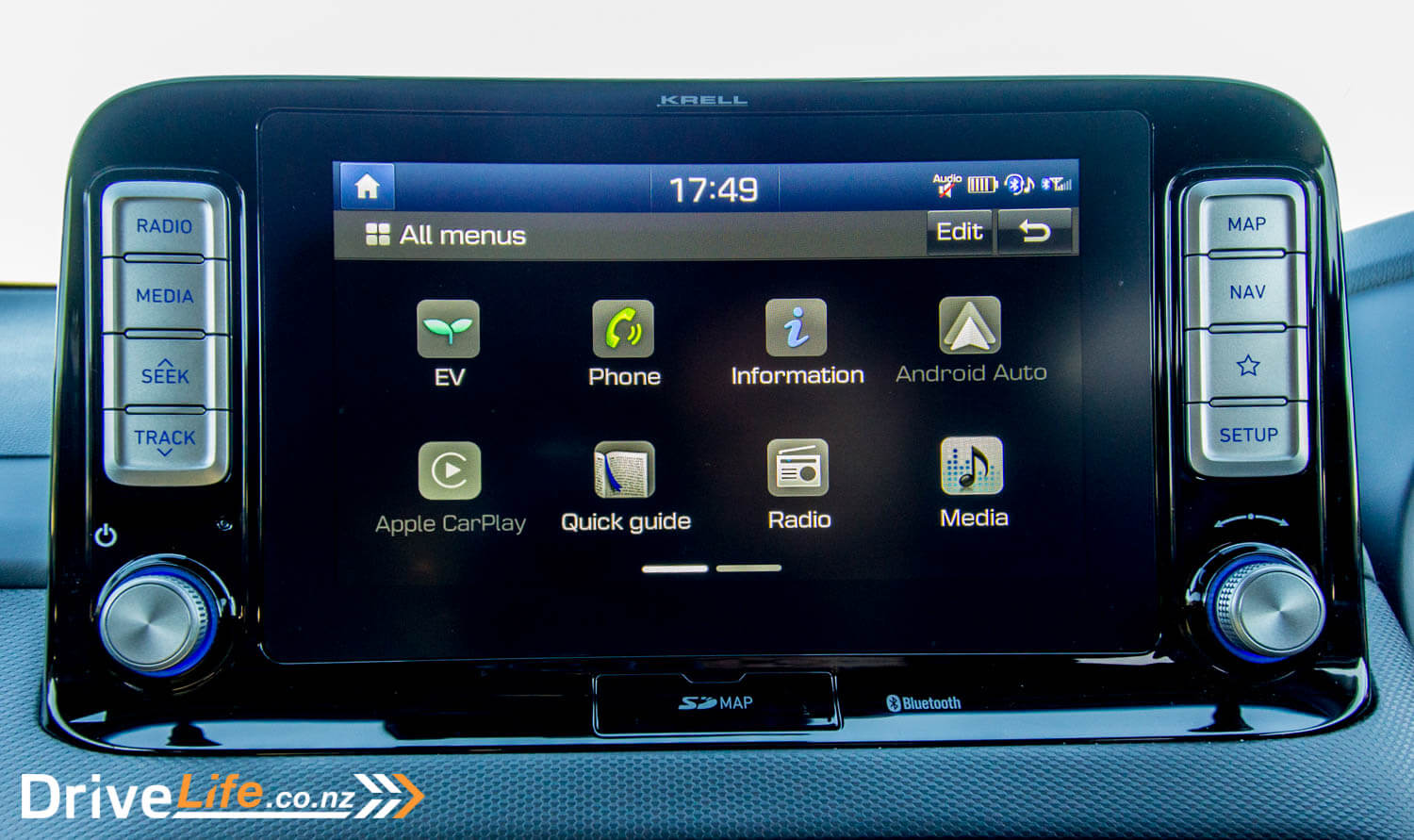
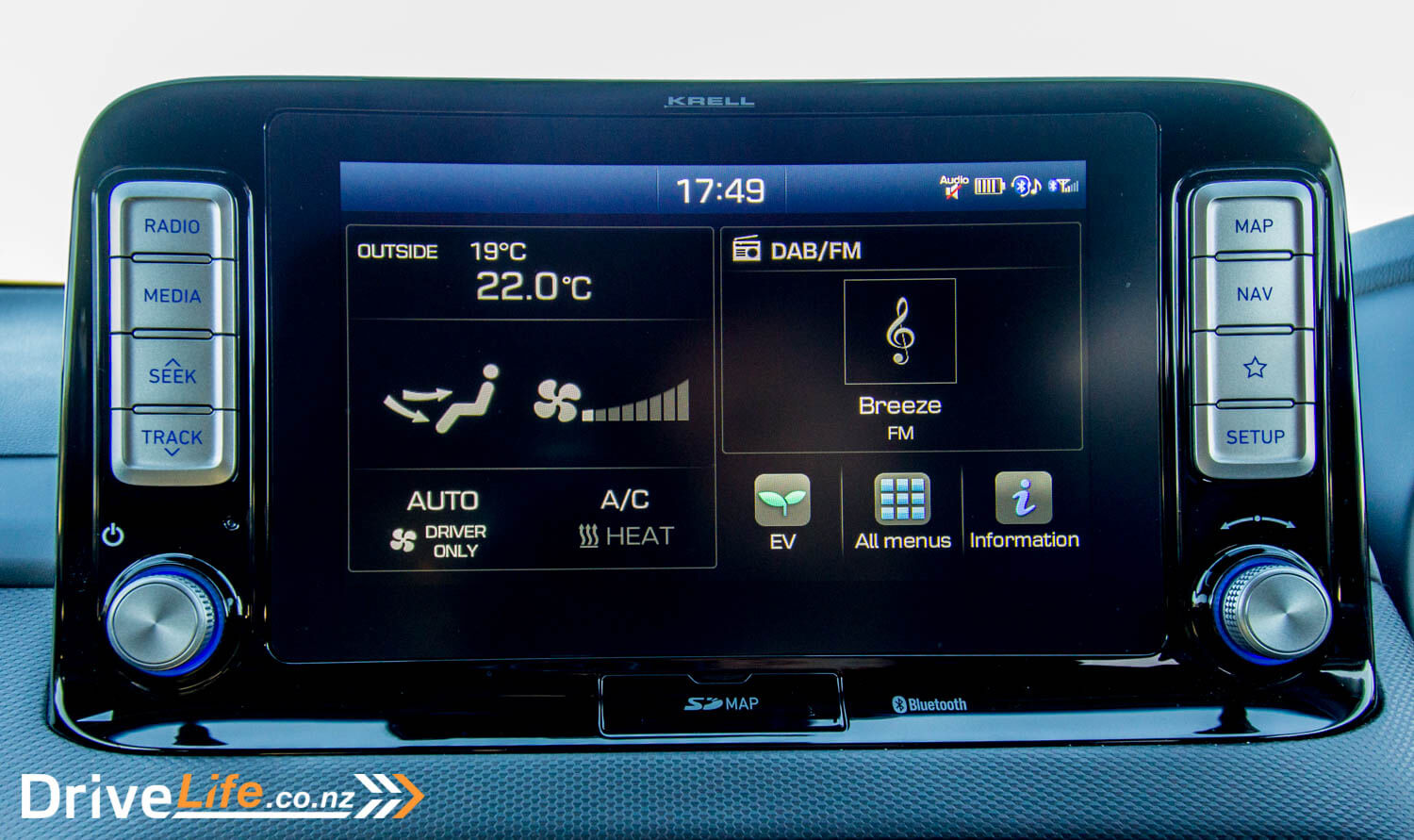
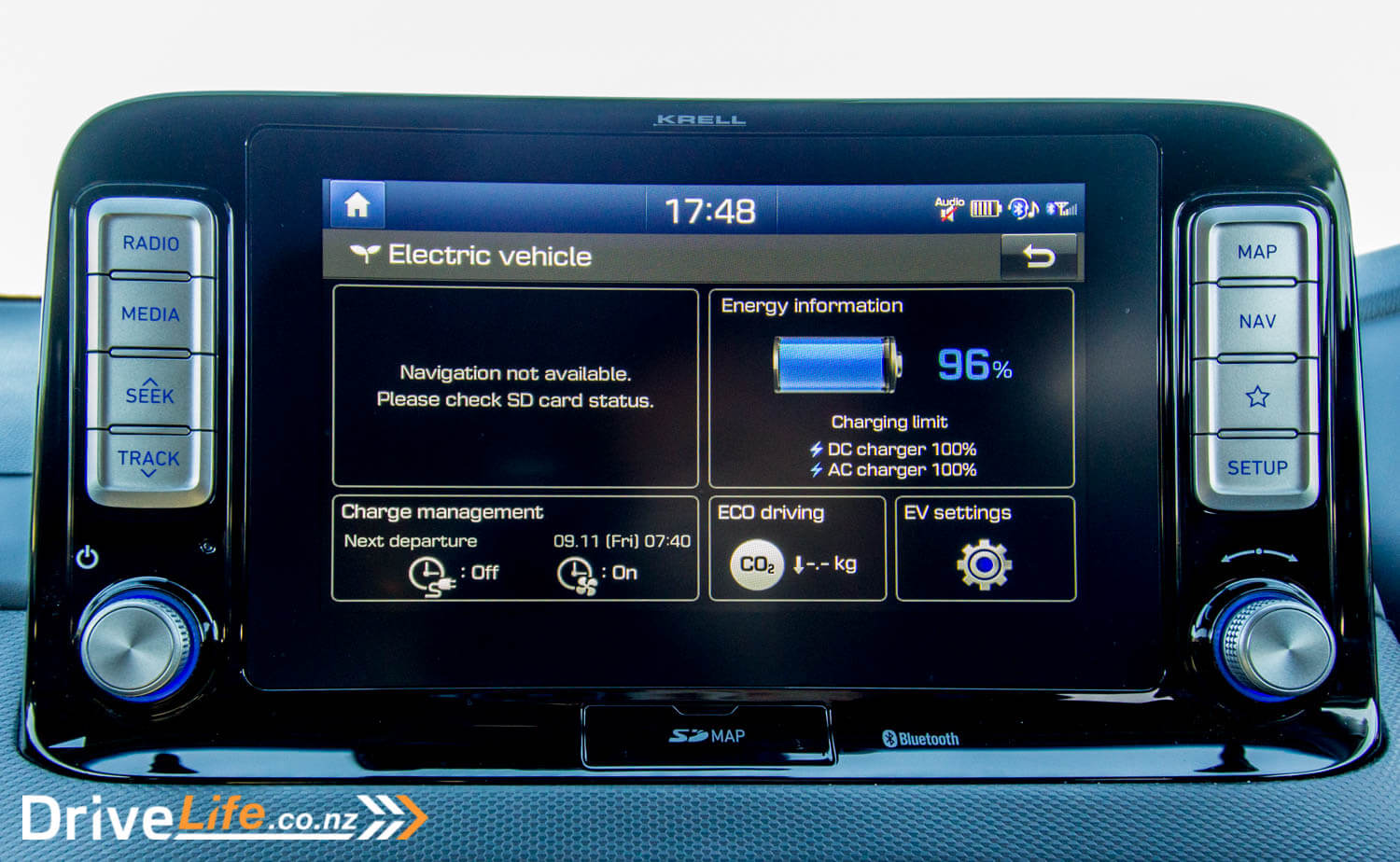
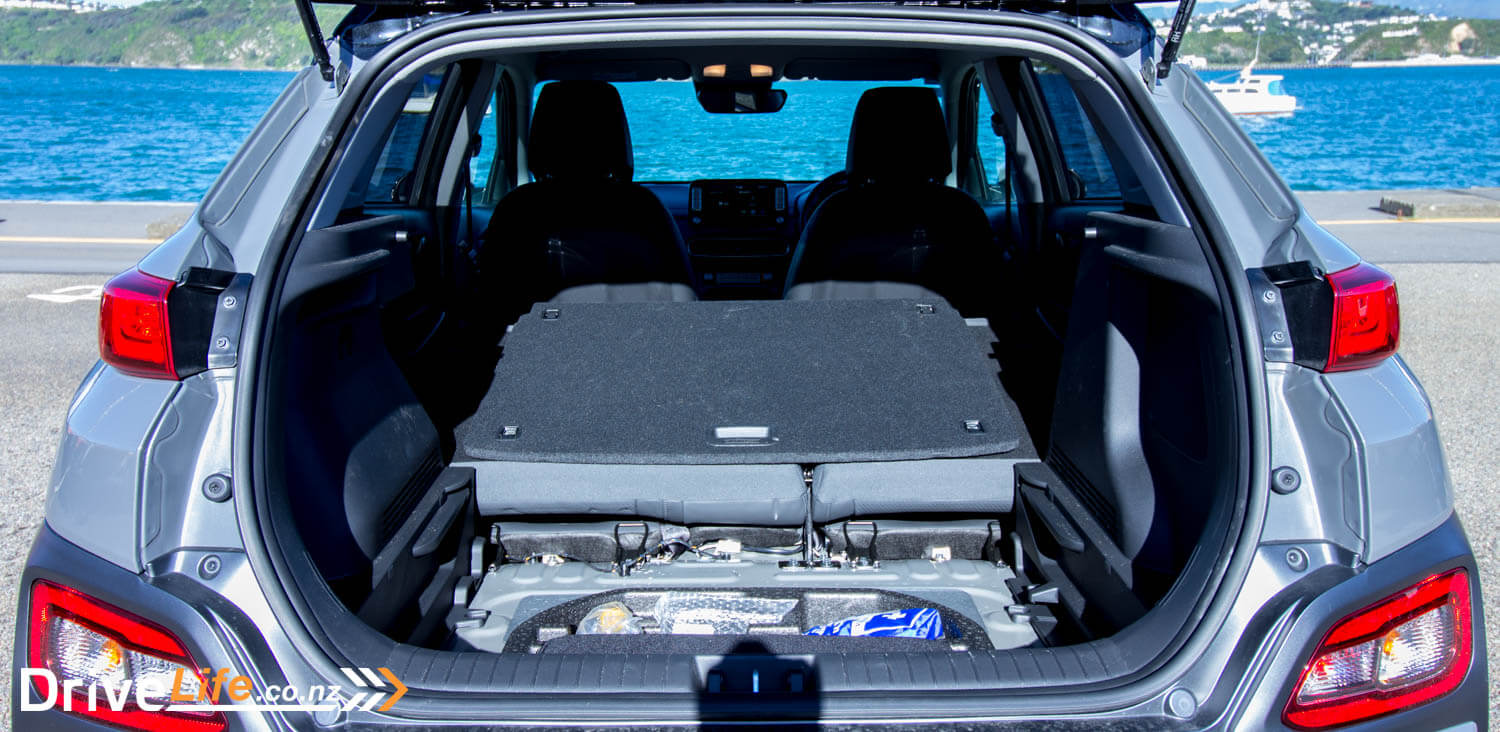
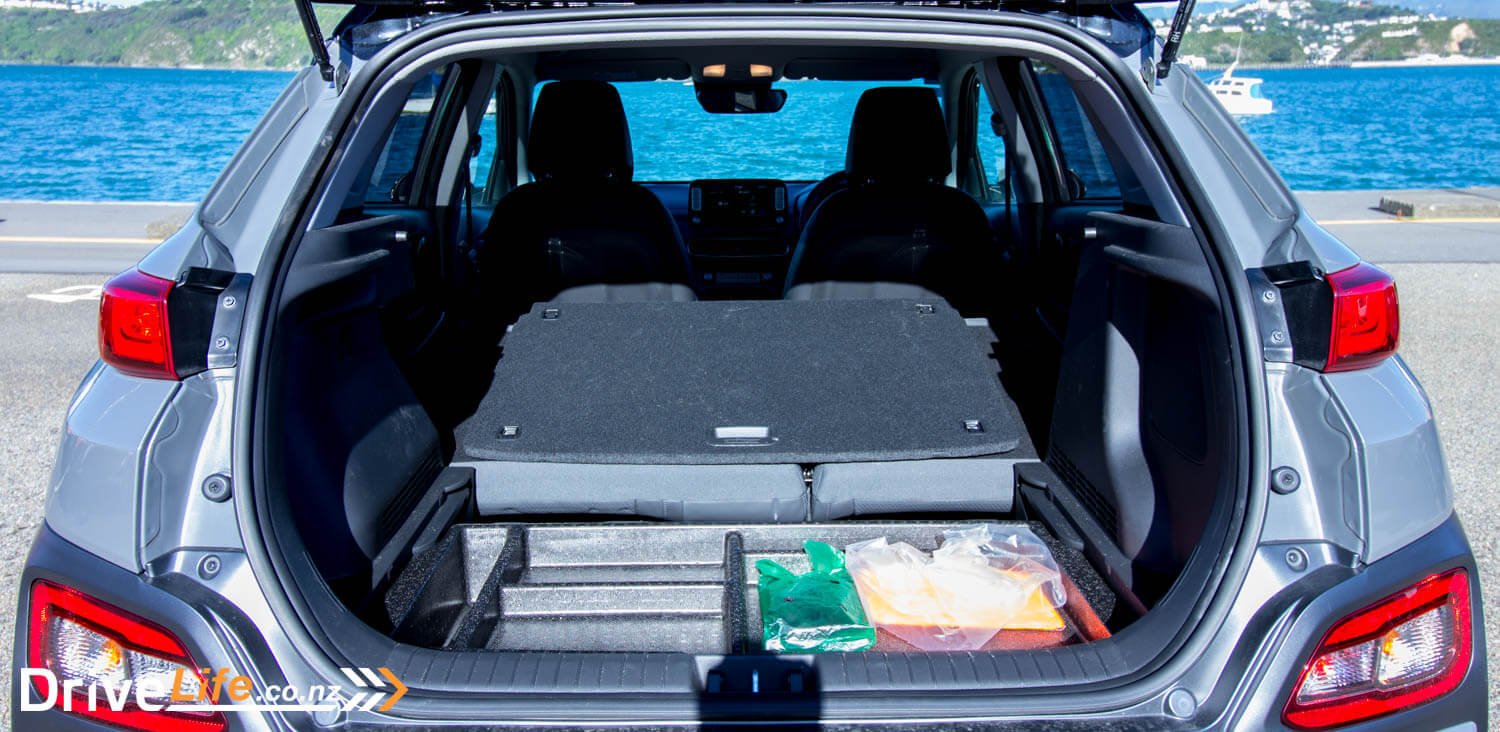
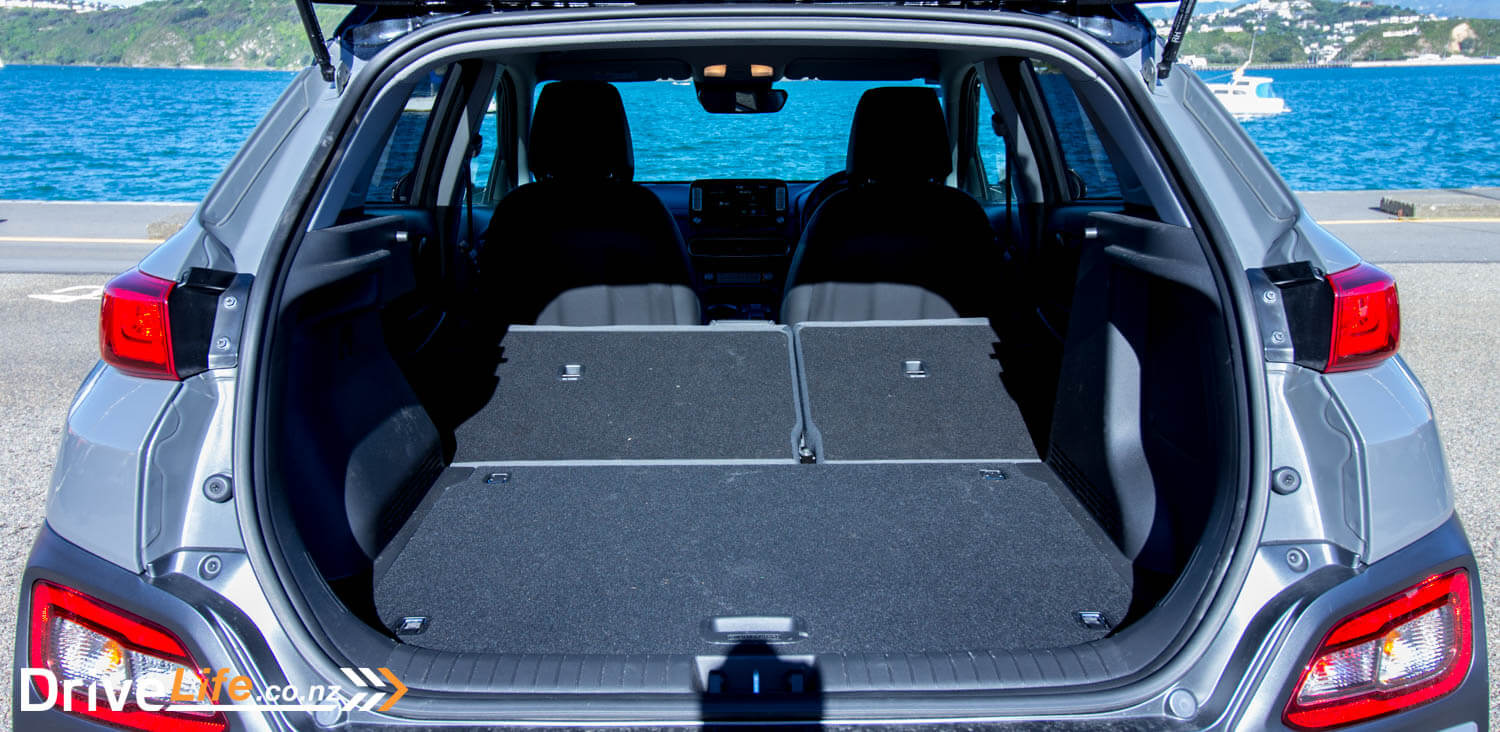
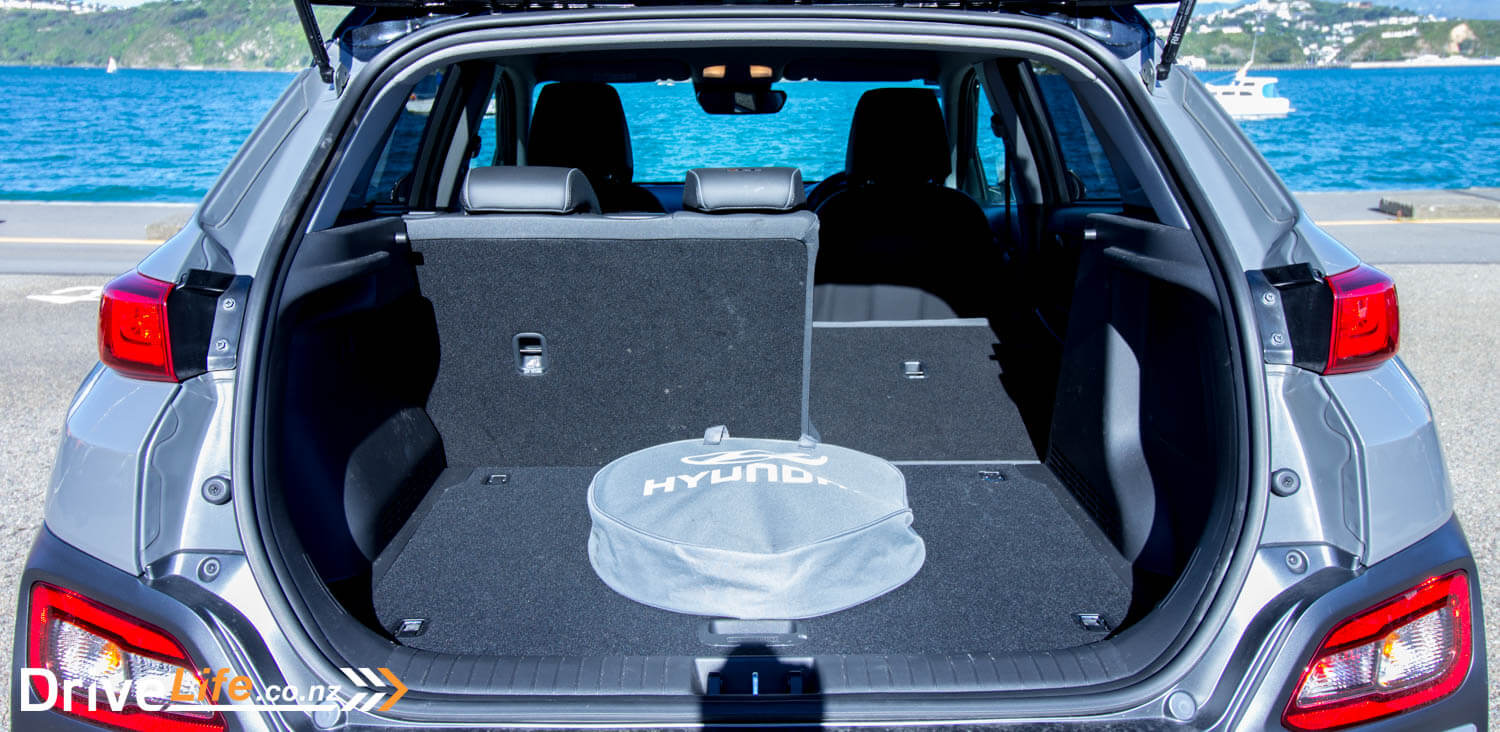

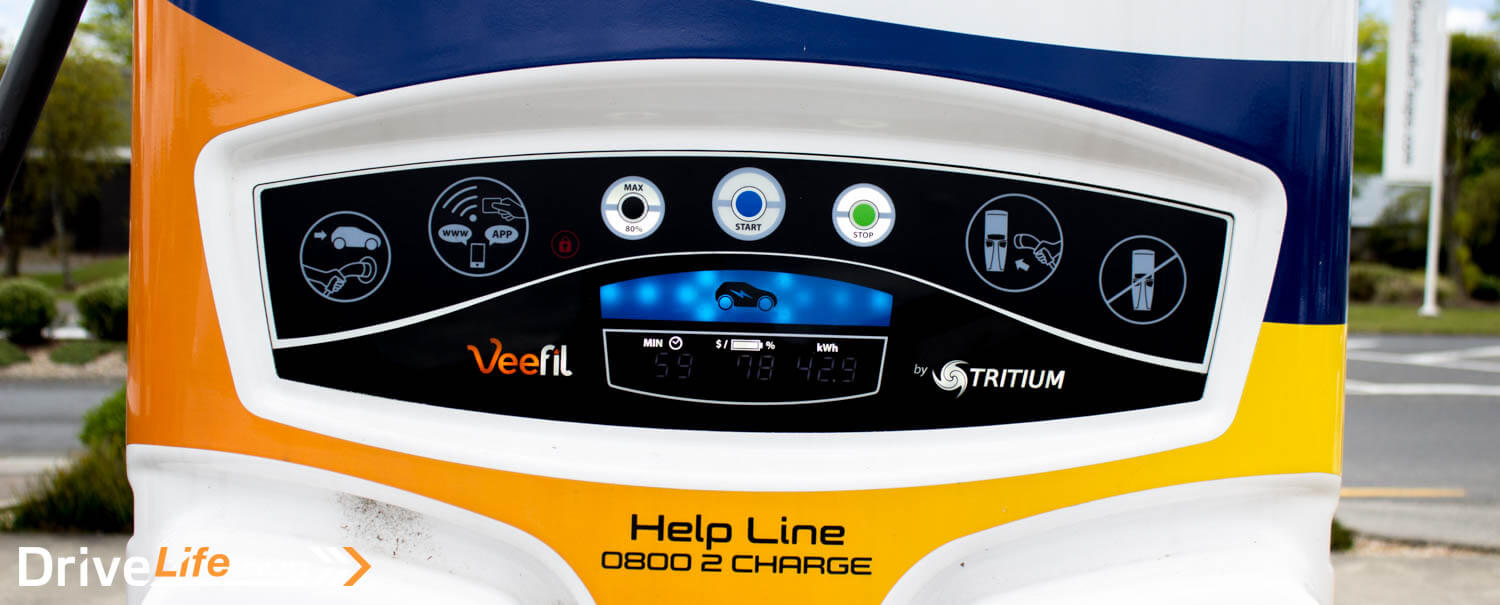


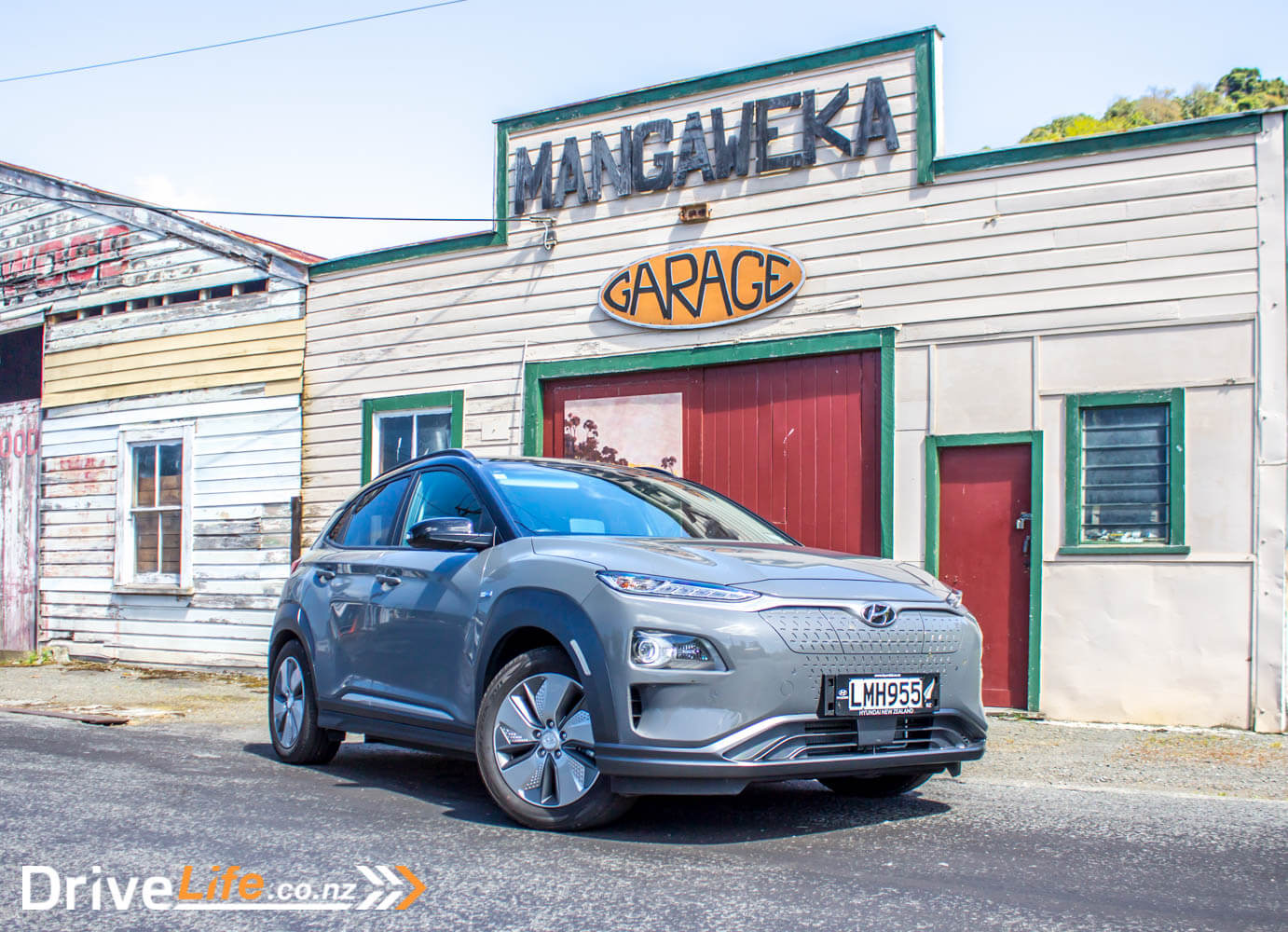






Great review and pics. An electric car needs a grille like it needs a fake exhaust – redundant and out of date (e.g. I find huge ones on the likes of latest Suzuki Siwft ridiculous and ugly). Silent, stink-free and faster off the mark then roaring guzzlers with quadruple tail pipes. If it gets really popular charge points may get crowded, like in Taupo there is one ChargeNet/Unison and 4 (four!) Tesla Onlys, not that I saw anyone charging on crowded New Year’s Eve. Lots of entry models on TradeMe, so got to be careful also in regard to SatNav. The cheapest Tesla 75D is $131,600 on https://www.tesla.com/en_NZ/models/design (probably due to further loss in exchange rate). NZ Tesla prices seem to align close to Aus, while the latter include 18-30K of Aus luxury taxes and duty (instead of incentives like in other countries) while NZ similar prices don’t – perhaps either margins or adds on shipping costs from Aus. Wish Hyindai switch both their mass production and TV ads from Santa Fes etc to the above Konas – EVs to the people.
A bummer IMO is that you get a 2WD-only “SUV” for twice the price of an AWD petrol version (using TradeMe as a guide), and accessories like roof rack and towbar in Hyundai website’s configurator only show up for the petrol version (though probably a technical glitch).
Also, without a spare tyre like in petrol version imagine yourself having a puncture in a middle of nowhere. The AA if you are lucky to have cellphone coverage will only arrange a tow truck (https://www.geekzone.co.nz/forums.asp?forumid=162&topicid=242094), so prepare for the top dollar to carry one in the trunk just in case.
They and the Government with their total lack of incentives are trying really hard to make us going green, do they…
HI Dmitry, thanks for the comments.
All very fair comments you make. Although it’s a personal thing with the grille – most people I chat to about the Kona EV, or other EVs agree – manufacturers seems to go out of their way to make them ugly. Does it need a grille for functionality? No. Could it look better than it does? Totally.
We did use the charge station in Taupo, right next to the 4 Tesla charge points, there was no queue which was great.
And 100% agree re advertising – there seems to be very little of it on television.
Cheers and thanks again
Fred
[…] Read more about the Hyundai Kona Electric on http://www.drivelife.co.nz […]
Thank you for a very comprehensive review. I am reluctant to do this, but can I ask that you please stop incorrectly referring to battery capacity in kW when the correct term is kWh (kilowatt hours). Kilowatts is a measure of power delivery, not storage capacity. It is like saying my tank stores 100 horsepower of petrol. It is important to not confuse people unfamiliar with EV terminology – there’s enough misinformation coming from the head-in-the-sand petrolheads already.
HI Tim
You are totally right! I can’t believe I got that wrong – I’ll go and sort it out and make sure any future EV reviews are correct. Thanks for letting me know.
Cheers
Fred